
The Complete Guide to IoT Testing: Frameworks, Challenges, Engineers & Best Practices
The Internet of Things (IoT) is rapidly transforming industries by connecting countless devices and objects to the internet. But this complex web of connected devices also introduces monumental software quality and reliability challenges. Even a single defect can lead to catastrophic downstream impacts across an entire IoT ecosystem.
Recent data indicates the IoT industry spends over $10 billion annually on recalling defective devices. Thorough testing is absolutely essential to avoid these catastrophic failures and safely realize the full potential of IoT.
In this comprehensive guide, we‘ll explore the critical discipline of IoT testing, including frameworks, techniques, challenges, roles, case studies, tools, and best practices. Let‘s dive in!
What Exactly is IoT Testing?
IoT testing refers to the practice of checking IoT systems for proper functionality, reliability, security, and performance. Testing validates all components of an IoT ecosystem:
- Sensors and Devices: Validating the capabilities of the embedded hardware like sensors, processors, and gateways.
- Network Protocols: Testing communication mechanisms like WiFi, Bluetooth, LTE enabling devices to share data.
- Cloud Platforms: Testing back-end infrastructure processing and analyzing IoT data.
- Applications: Testing management apps and analysis dashboards.
- Data Pipelines: Testing the end-to-end flow of data across devices, networks, cloud, and apps.
Testing ensures all these components work individually and interconnect properly to deliver the intended behavior.
IoT Testing Approaches and Methodologies
Experts utilize a wide variety of testing approaches to validate the correct functioning of IoT systems:
Performance Testing
Performance testing under load is critical to ensure responsiveness and reliability as usage scales. Key aspects include:
- Load testing: Validating performance as user load increases to uncover bottlenecks.
- Stress testing: Overwhelming the system with extreme load to test robustness.
- Endurance testing: Testing over an extended duration to reveal memory leaks or crashes.
Performance testing applies to networks, cloud platforms, applications, and gateways. Metrics like latency, throughput, jitter, and uptime are measured to quantify system behavior under load. Specialized tools like NeoLoad are used to simulate millions of concurrent device messages and users.
Security Testing
The interconnected nature of IoT systems requires rigorous security testing to avoid severe vulnerabilities being exploited. Techniques include:
- Penetration testing: Ethical hackers try breaching networks and devices to reveal weaknesses.
- Fuzzing: Random invalid data is injected to identify crashes and flaws.
- Risk assessments: Experts conduct audits to determine security gaps before testing.
Multiple reports have shown IoT systems riddled with elementary security flaws. Comprehensive security testing is essential across devices, cloud APIs, web/mobile apps, and networks.
Compatibility Testing
The tremendous diversity of devices, operating systems, and platforms in IoT ecosystems requires extensive compatibility testing. Testers validate seamless integration between:
- Operating systems: Windows, Linux, real-time OSs across devices.
- Browsers: Chrome, Safari, Firefox for web apps.
- Protocols: ZigBee, MQTT, CoAP, BLE for distributed devices.
- Chipsets: Qualcomm, MediaTek, Intel across hardware.
Rigorous compatibility testing provides confidence in heterogeneous IoT environments. Test cloud simulators like DeviceAnywhere can remotely test thousands of real device/OS combinations.
Functional Testing
Validating that key features behave as intended based on requirements. Performed at unit, API, and system levels. Methods include:
- Test cases: Executing pre-defined test cases mapping to requirements.
- Boundary testing: Testing upper and lower limits of valid input ranges.
- Negative testing: Validating system behavior for invalid inputs.
- Smoke testing: Quick end-to-end validation before release.
Test automation is heavily leveraged for repetitive test cases. Frameworks like TestComplete are popular for automating mobile and web testing.
Usability Testing
Evaluating user experience across devices and interfaces. Critical for devices like wearables with compact interfaces. Methods include:
- Lab testing: Observing participants performing tasks on devices/apps.
- Surveys: User feedback on challenges and areas for improvement.
- Expert reviews: Experts critique interfaces based on ergonomic principles.
Multiple Iterative tests uncover usability hotspots. This ensures users can onboard and operate devices easily.
Other IoT Testing Types
- Localization testing across global languages and regional settings.
- Compliance testing to standards like IEC 62304 for medical devices.
- Interoperability testing to ensure disparate IoT systems can exchange data.
- Pilot testing with limited real-world deployments to uncover defects.
- A/B testing of interface variants to determine optimal performance.
The Monumental Challenges of IoT Testing
While rigorous testing is clearly imperative for dependable IoT implementations, executing comprehensive test plans presents massive challenges:
1. Complexity of Use Cases
The interconnectivity of IoT devices and systems enables incredibly sophisticated use cases. Testing every possible scenario is impractical. Prioritizing high-risk use cases is necessary.
2. Diversity of Devices and Platforms
A single IoT ecosystem contains a vast diversity of device types, hardware versions, operating systems, protocols, and platforms. Attempting to test all variants is tedious and resource-intensive.
3. Real-Time Performance Needs
Many IoT systems monitor events and enable time-sensitive actions. Realistically simulating and testing ultra-low latency needs at scale is hugely complex.
4. Massive Scalability Requirements
A full-scale IoT deployment may span thousands of devices across locations generating terabytes of data. Mimicking this in test environments taxes resources.
5. Mission-Critical Reliability Needs
An IoT monitoring a patient‘s health simply cannot go down unexpectedly. Ensuring this mission-critical reliability under all conditions is difficult.
6. Security Concerns
The connected nature of these systems requires the most rigorous security testing possible. But comprehensive security validation is enormously challenging.
7. Remote Testing Limitations
When devices are dispersed across distant environments, directly testing them is not feasible. Debugging hardware remotely makes fixes difficult.
These imposing challenges underscore why many IoT test teams struggle to deliver the required degree of quality assurance. Adopting leading practices and tools is necessary to overcome these barriers.
Real-World IoT Testing Case Studies
To understand IoT testing in action, let‘s examine real-world examples from diverse industries:
Medical Devices Company
- Challenge: Rigorously test an IoT-enabled infusion pump for safety and reliability.
- Approach: Hardware-in-the-loop testing to simulate real clinical environments and use cases. Focused on failure mode testing.
- Results: Identified critical defects pre-launch. Significantly improved quality and safety.
Oil and Gas Giant
- Challenge: Evaluate network of remote IoT oil rig sensors for performance and uptime.
- Approach: Built simulated test lab matching real deployments. Used automated testing.
- Results: Improved system stability and avoided $100Ks in downtime costs.
Automotive Leader
- Challenge: Test autonomous vehicle systems for safety across millions of scenarios.
- Approach: Leveraged sensor simulation and test automation to efficiently validate critical driving scenarios.
- Results: Accelerated testing by 70%. Reduced serious software bugs by 40%.
Smart City Project
- Challenge: Validate complex city-wide IoT infrastructure pre-launch.
- Approach: Large-scale load testing simulating real-world traffic volumes across all city systems.
- Results: Ensured systems could handle operational demands before rollout.
These examples showcase the breadth of real-world testing needs and proven approaches to tackle them.
IoT Test Engineer Role and Responsibilities
Executing comprehensive testing requires dedicated IoT test engineers with specialized expertise. Key responsibilities include:
- Developing test plans and cases mapped to IoT system requirements.
- Building and maintaining test environments and lab setups.
- Instrumenting systems to inject faults and collect metrics.
- Automating repetitive test execution for efficiency.
- Performing hands-on exploratory testing to find edge defects.
- Evangelizing quality best practices across engineering teams.
Essential skills include automation proficiency, understanding of IoT protocols/cloud platforms, knack for instrumentation, and analytical problem-solving.
As devices become increasingly software driven, demand for skilled IoT test talent will rapidly accelerate.
Top IoT Testing Frameworks
Specialized open-source frameworks help accelerate IoT testing:
IoTBox: Lightweight test harness for IoT devices and apps. Intercepts device communication for testing. Easy to integrate.
RIOT: Used for testing embedded IoT device software on hardware boards like Raspberry Pi.
IoTify: Modular framework for testing IoT apps and hardware. Includes utilities for test management.
espressif/esp-idf: Test framework for ESP32 WiFi/BT IoT chips by Espressif.
Axe: Accessibility testing framework for IoT web interfaces. Checks compliance to standards.
These frameworks simplify executing common testing workflows for IoT systems.
Key IoT Testing Tools
Specialized tools help streamline and automate IoT testing:
- SmartBear TestComplete: Testing IoT mobile apps and websites. Integrates with developer IDEs.
- Parasoft SOAtest: API testing for IoT cloud platforms and application interfaces.
- Ranorex: Automated testing of IoT device GUIs and interfaces.
- Neotys NeoLoad: Load and performance testing tailored for IoT ecosystems.
- Fortify on Demand: Scans IoT systems for security vulnerabilities.
- Experitest SeeTest: Automating mobile and web testing across real devices.
- Mongoose: Traffic generator for rigorously testing IoT networks and hardware.
These tools accelerate activities like test case execution, defect reporting, and environment simulation.
Best Practices for IoT Testing
Here are key best practices to enable effective testing for IoT initiatives:
- Start testing early during design phase to uncover hidden assumptions.
- Prioritize testing for high-risk scenarios with potential for severe impact.
- Leverage test automation wherever possible to increase coverage and repeatability.
- Perform security testing continuously, not just at the end. Make it a priority.
- Test across simulated environments reflecting real-world operational conditions.
- Use real devices and infrastructure to uncover hardware-software gaps.
- Focus on exploratory testing beyond scripted scenarios to find unpredictable issues.
- Monitor tests with instrumentation to gather performance data.
- Adopt DevSecOps culture promoting shared responsibility for quality across teams.
Apply these practices to overcome IoT testing bottlenecks and deliver higher quality implementations.
The Future of IoT Testing
As IoT adoption accelerates, testing will rapidly evolve:
- AI-assisted testing will help automatically generate optimal test cases.
- IoT test automation will increase dramatically thanks to maturing tools and frameworks.
- Testing practices will shift left toward emphasizing prevention over finding defects.
- IoT systems will be instrumented early on to enable transparency into quality.
- Security testing will happen continuously to protect dynamically changing attack surfaces.
- Test data strategies will mature to deal with exploding volumes of test data.
Forward-looking organizations are already pioneering these innovations to realize IoT benefits while managing risk.
As this guide has shown, rigorous IoT testing is crucial for managing the inherent complexity of IoT ecosystems and delivering reliable business outcomes.
By combining robust test data, automation frameworks, and dedicated IoT test engineers, organizations can overcome IoT testing challenges. With diligent use of proven practices and tools, you can confidently deploy high-quality IoT systems that live up to their transformative potential.
I am Paul Christiano, a fervent explorer at the intersection of artificial intelligence, machine learning, and their broader implications for society. Renowned as a leading figure in AI safety research, my passion lies in ensuring that the exponential powers of AI are harnessed for the greater good. Throughout my career, I've grappled with the challenges of aligning machine learning systems with human ethics and values. My work is driven by a belief that as AI becomes an even more integral part of our world, it's imperative to build systems that are transparent, trustworthy, and beneficial. I'm honored to be a part of the global effort to guide AI towards a future that prioritizes safety and the betterment of humanity.
Similar Posts
5 key ways data monitoring powers business agility.
Real-time data monitoring is mission-critical for making fast, confident decisions. Here are 5 ways continuous data…
Top UiPath Process Mining Alternatives for 2023: A Data-Driven Comparison
Process optimization has become a top priority for many organizations today. According to a recent McKinsey…
ChatGPT Passes Turing Test: A Turning Point for Language Models
The recent news that ChatGPT, an AI chatbot created by OpenAI, passed the famous Turing Test…
GPT-4 Demo: A Deep Dive into the Technology and Implications
Earlier this month, the AI community was abuzz with excitement about OpenAI‘s livestreamed GPT-4 demo. As…
XR/AR in Healthcare: Top 10 Use Cases in 2023
Are you interested in how extended reality (XR) is transforming healthcare? In this comprehensive guide, we‘ll…
Looking for the Best Stonebranch Alternative in 2023? Here Are the Top 5 Options
Searching for a workload automation tool that‘s an upgrade from Stonebranch Universal Automation Center (UAC)? In…
- For Small Business
IoT Testing: Framework, Challenges, Case studies & Tools 2023
- March 17, 2024
- by Terry Tolentino

The rapid proliferation of IoT (Internet of Things) devices and applications is transforming industries, but it also brings immense testing challenges. Validating the quality and reliability of connected IoT systems requires thorough testing across the entire ecosystem – including devices, gateways, networks, cloud platforms, and applications. However, traditional testing methods fall short in addressing the complexities of an interconnected IoT environment.
Recent research by Vanson Bourne found that enterprises spend over $10 billion annually just to recall defective IoT products. Proper IoT testing during development is the only way to avoid such huge costs of failure after deployment. This article provides a comprehensive guide to IoT testing and how businesses can build a robust methodology.
What is IoT Testing?
IoT testing refers to the practice of testing IoT devices, systems, and communication protocols to ensure correct functioning, interoperability, reliability, and security.
An IoT ecosystem comprises of four key components:
- Applications : Mobile or web apps providing user interfaces and experiences.
- Networks : Communication protocols like MQTT, CoAP connecting devices.
- Data Centers/Cloud : Backend infrastructure for processing and analytics.
- Devices/Sensors : Embedded systems collecting data and controlling actuators.
IoT testing aims to validate each component and their interactions through various methodologies. The goal is to have an end-to-end understanding of the entire connected system.

IoT Testing Approaches and Tools
Several testing approaches are required to fully validate an IoT system:
Performance Testing
This testing focuses on peak load capability, reliability, and resource usage of an IoT system. Specific aspects tested are:
Network Protocols – Tests throughput, latency, and stability of protocols like MQTT, CoAP under different load conditions. Tools like JMeter, Gatling, Locust can simulate IoT workloads.
Cloud and Backend – Validates scalability of backend processing, databases, analytics engines under expected load. Tools like LoadRunner, NeoLoad generate load for testing.
Embedded Software – Stresses computation performance in device operating system and processors using tools like Perf to find bottlenecks.
As per recent survey by Precisely, 92% of IoT developers consider performance testing important for IoT applications.
Security Testing
Validates the system against vulnerabilities like data leaks, malware attacks, unauthorized access, DoS attacks etc. It involves:
Device Security – Testing for risks like hard-coded passwords, encryption, firmware hacks using tools like Binwalk, Firmadyne.
Network Security – Testing VPNs, firewalls, TLS/SSL using tools like Nmap, Metasploit, to prevent threats like MITM attacks.
According to research by Palo Alto Networks, 84% of organizations have faced IoT security breaches, highlighting the need for robust security testing.
Compatibility Testing
Verifies seamless working across different hardware platforms like ARM, x86, operating systems like RTOS, Ubuntu, and software components. API testing tools like Postman and compatibility testing frameworks like Appium can accelerate this testing.
Functional Testing
Validates all functional use cases and business logic flows in an IoT system. Various techniques like boundary value analysis, equivalence partitioning are used to design test cases. Both blackbox and whitebox testing approaches apply here.
Usability Testing
Evaluates ease of use and simplicity of user interfaces for visualizing and controlling IoT systems. Feedback on UI/UX is collected from target users to identify areas of improvements.
Other Testing Types
Localization Testing – Validating localization and globalization aspects.
API Testing – Testing application programming interfaces with tools like Postman.
Interoperability Testing – Checking if interconnected devices and systems can operate seamlessly.
Compliance Testing – Validating regulatory standards like ISO 9001, IEC 62304.
Data Integrity Testing – Testing accuracy and consistency of data across the system.
Key Challenges in IoT Testing
Though testing is crucial for IoT deployments, it comes with multiple challenges:
Complex Use Cases and Real-Time Performance
IoT applications have complex real-time behavior with dynamic inputs across locations. Testing all possible scenarios is difficult. Defects can severely impact revenue and human lives.
Diverse Hardware and Software Platforms
Too many combinations of hardware platforms like ARM Cortex, MediaTek, operating systems like Contiki, RIOT, and diverse software libraries make complete testing very challenging.
Multiple Communication Protocols
There are diverse set of communication protocols – like MQTT, CoAP, XMPP, LWM2M etc. Testing interoperability between them consistently across devices with simulators like Eclipse Mosquitto is hard.
Resource Constrained Devices
Many IoT devices have constraints like low memory, compute power, battery life etc. Traditional testing tools may not work here and need customization.
Large-Scale Sensor Data
Potentially thousands of sensors produce enormous volume of test data. Validating sensor data at scale and identifying anomalies among signal noise is difficult.
Security Concerns
Connected systems are prone to new risks like data leaks, firmware hacks, DoS attacks etc. Testing for such vulnerabilities is very complex given large attack surfaces.
Lack of Testing Standards
Unlike software testing, there are no well-defined IoT specific testing standards yet. This makes defining the right test coverage difficult.
Role of Test Automation in IoT
While manual testing provides flexibility, test automation is imperative for IoT given the scale and complexity. Some key focus areas for automation:
API testing : Automated testing of device APIs using framework like REST-assured.
Performance Testing : Using tools like JMeter, Gatling for load generation and testing at scale.
Functional Testing : Auto-executing test cases across devices and simulators with Selenium, Appium etc.
Device Testing : Emulators like Android Emulator, Genymotion used for automated validation across devices.
Security Testing : OWASP ZAP, Burp Suite used for identifying vulnerabilities within IoT apps.
Real-World Examples of IoT System Testing
Here are two examples of comprehensive testing done for real-world IoT systems:
Smart Factory Monitoring and Control
Client : Automotive manufacturing company
Application : Monitoring of assembly line systems and machine telemetry
Testing Scope :
- Functional testing of edge systems and gateway software
- Performance testing and benchmarking
- Security testing for vulnerabilities
- Reliability testing with sensor simulation
- Automated regression testing
- Improved assembly line efficiency by 12%
- 60% faster detection and debugging of any machine failures
- Hardened security measures for equipment access and data transfer
Smart Building Management Solution
Client : Real estate developer
Application : BMS and automation of lighting, HVAC, security systems
- Interoperability testing for 30+ IoT hardware types
- Localization testing across 7 regional languages
- Accessibility testing for compliance standards
- Energy savings calculated through metering data accuracy tests
- Fault injection testing for reliability
- Seamless integration with building equipment from multiple vendors
- Intuitive user experience for residents across locales
- Reduced events of false alarms and malfunctioning by 35%
- Accurate analytics for energy optimization
Choosing the Right IoT Testing Tools
With a wide variety of tools available, selecting the right ones based on the testing scope is important:
- Functional Testing : Selenium, Appium, Calabash, Espresso
- API Testing : Postman, REST Assured, Karate API
- Performance Testing : JMeter, Gatling, Locust
- Security Testing : Burp Suite, OWASP ZAP, Metasploit, Nmap
- Device Testing : Ranorex, TestProject, Kobiton, Experitest
- Monitoring : Prometheus, Grafana, AppDynamics
- Test Automation : Robot Framework, Cucumber
- CI/CD : Jenkins, AWS CodeBuild, CircleCI
Best Practices for IoT Testing
Based on our experience, here are some key best practices for effective IoT testing:
Start testing early during the development lifecycle for faster feedback
Implement continuous testing integrated with CI/CD pipelines
Test on real devices as far as possible to uncover hardware-related defects
Generate high test coverage across components using automation
Conduct security testing periodically to find vulnerabilities
Focus on interoperability and compatibility testing
Define metrics to measure test progress, coverage, and outcomes
Prioritize test cases wisely based on risk to maximize effectiveness
Analyze test reports to identify weak spots and enhance testing
The Road Ahead
As IoT adoption grows across industries, comprehensive testing practices are crucial for success. A holistic framework, intelligent automation, and the right set of tools will be key to overcoming IoT testing complexity.
With their experience and expertise in testing complex systems, independent software testing companies remain the best partners for enterprises to build robust IoT testing practice.
However, businesses also need to invest in training their own teams and building in-house capabilities. This will accelerate testing and validation for faster release of innovative IoT solutions.
Proactive planning, continuous improvement, and adoption of emerging technologies like AI for testing will shape the future of efficient and reliable IoT testing.
Internet of Things (IoT) Testing: Why Is It So Important?
- Internet of Things (IoT) Testing: ...
The Internet of Things has become a top-trending technology — the supply and demand for IoT solutions are higher than ever. Still, that’s just the beginning.
If in 2019, the number of connected IoT devices was over 7,74 billion, then by 2030, according to the most conservative estimates, there will be 25,44 billion. And that figure will grow even higher if we can address IoT solutions security and interoperability issues.
200+ companies from 25 countries outsourced software development to Relevant
We provide companies with senior tech talent and product development expertise to build world-class software. Let's talk about how we can help you.

The more devices connect to the Internet of Things, the more important it is to keep the system effective and safe. However, traditional quality assurance services methods are no longer sufficient. Many devices require early testing, especially those undergoing continuous integration.
Since Relevant is an IoT expert and seasoned IoT software development company, we will explain the concept of IoT testing and why it is one of the most significant steps in an IoT project deployment.
Table of Contents
What is IoT Testing?
The Internet of Things comprises three key components – devices, communications, and computing. Devices are things or physical objects connected to the Internet. The second component is communication, which is carried out via Wi-Fi or satellites and cellular services and is very important to keep the entire system working.
The third component is computation, which is done in a central location on the server and allows the system to run efficiently. An IoT application helps integrate all three elements for intelligent decision-making.
However, the heterogeneity of underlying devices and communication technologies and the need for interoperability at different levels – from communication and seamless integration of devices to the interaction of data generated by IoT resources- hinder the implementation of common IoT solutions globally.
Because the IoT is a network that communicates in real-time, performance and security issues in any part of it can negatively affect the performance of the rest of the network. One node compromised by a cyberattack can harm others. Therefore, you must detect all weak points before the product reaches consumers.
That’s what IoT testing is for – a series of QA tests designed to validate functionality, performance, and security, in which all devices take part, regardless of their shape, size and location.
Since the IoT is a fragmented system, there are certain difficulties associated with the testing process. These can be eliminated by setting up large test teams to examine all components for reliability across multiple platforms and devices.
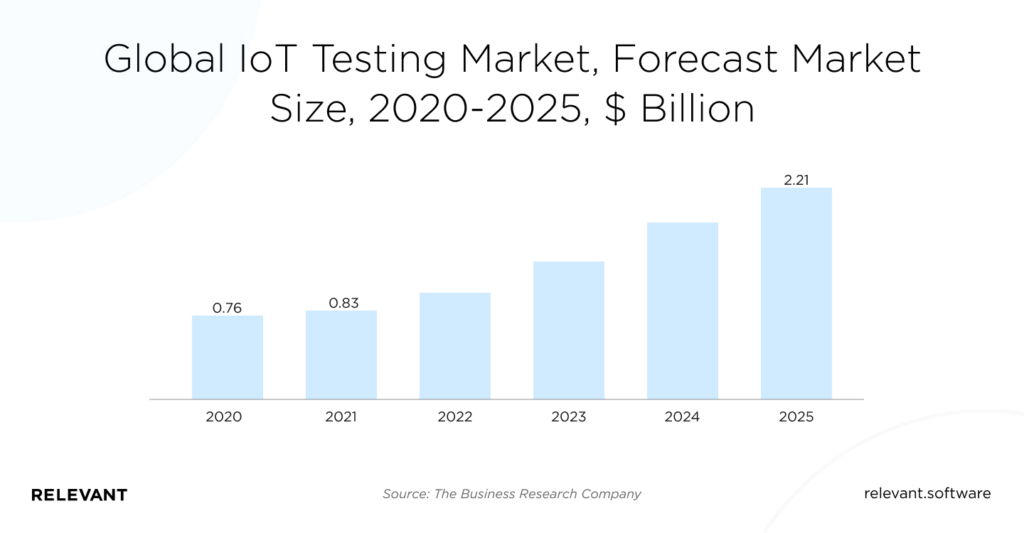
What are the IoT testing types?
In theory, testing IoT solutions is similar to testing other software products; in reality, it has some distinctive peculiarities. Test types fall into two basic categories, which include separate subcategories.
Functional testing
As you might guess from the name, it involves checking how various functional aspects work. This group includes, for example:
- Unit testing. It tests each module or component of an application. The IoT development team usually performs this task.
- Integration testing. When all modules are integrated, it is essential to see how they work together.
- End-to-end testing. This type involves running tests for the entire software product.
- Smoke testing : This type of testing helps determine if the software is stable enough.
- Regression testing. Each added module leads to changes in the program. If it takes any updates to the firmware of the IoT device, they can also lead to changes in the system. It is crucial to ensure that all components are still working correctly after each update.
- Interface testing. Testers verify the GUI meets the specified requirements and specifications.
Non-functional testing
It focuses on aspects such as performance, reliability, security. In this category, we can define the following types:
- Performance testing. This process focuses on identifying software performance problems.
- Security testing. Because data security is vital to most IoT solutions, this type of testing is incredibly rigorous.
- Load testing. That allows you to determine how much load the software can withstand without degrading performance.
- Stress testing. These tests help you assess whether the system is performing as expected when there are insufficient resources.
- Compatibility testing. It will help you check if the application can work on different platforms / in different environments without errors and other problems. These tests are appropriate when the software is completely stable.
There are up to 40 types of testing in total. Let’s inspect the most used options for the Internet of Things in more detail.
Compatibility testing
Since IoT systems are built after multiple hardware and software configurations, the crucial phase of IoT testing should begin with running compatibility tests. This process typically involves testing various devices, browsers, operating systems, and communication modes to ensure maximum compatibility.
It determines whether a target product that implements a standard specification is compatible with other products that implement the exact specification. Each software component must recognize input from other programs, handle the workload associated with its role in the architecture, and provide accessible and valuable results.
Tip: Check the response time against a specific time and if the data sent is accurate.
Performance testing
The second phase of IoT software testing begins with validating the performance-related implementation. Some of the key factors that the performance testing process typically deals with include:
- Performance under maximum load or data.
- Testing system for several devices at the same time.
- Communication tests between devices.
- System usability such as RAM load, battery usage, power consumption.
- Testing the device under various network conditions and environmental factors.
It helps you test the speed of IoT applications in data-intensive environments. Testers can simulate heavy loads using cloud platforms and create custom scripts to test the program in challenging environments.
Tip: Performance testing in IoT should be done at the network and gateway level (protocols such as MQTT, HTTP, CoAP), system-level (processing, analytics, database), and application level.
Connection testing
The third testing stage ensures uninterrupted connectivity even when users cannot have a complete set of data. The stability of the IoT system depends on how well the devices and the hub are connected. After all, if it loses the connection for at least one second, it can cause data inaccuracy and system instability. Flawless connectivity, besides data recovery, is one of two critical features of connectivity testing.
Tip: Don’t forget to register all gadgets taking part in the IoT test with the network. Send periodic ping messages to make sure the error persists. The device must save the data to the database, which syncs with the hub to restore the connection (device shadow in AWS).
Usability testing
Because the user receives data on IoT devices in real-time, IoT software interfaces need to be manageable and informative. Usability testing ensures that the end-user gets intuitive and straightforward software that harmoniously represents all the graphical elements.
Tip: Ensure the IoT application has all its features, accords to the specifications, and checks user experience (UX).
Security testing
Because IoT software requires a lot of data for an application to function correctly, IoT security testing methodologies are essential to developing a robust IoT testing strategy. It includes three levels of testing.
- Network testing. It protects the IoT application from potential network layer attacks.
- System testing. It will ensure that user data is safe and well protected from leakage and hacking.
- Testing of IoT devices. This kind of test ensures that devices for an IoT application are protected from problems related to APIs, authentication, updates, configuration settings, etc.
Tip: Check for unauthorized access to the device, or make sure you can remotely delete data on jailbroken devices.
Beta testing
This type of user testing IoT requires testers to model realistic IoT test scenarios. That helps them prevent users from having problems with the final version of the IoT application and increases the chances of a successful release. It also helps business owners reduce bug fixing costs as glitches and usability issues are discovered during the beta phase.
By applying IoT testing, you can test IoT software at all stages of its development.
IoT Testing framework: What is it all about?
Testing for the Internet of Things requires a robust environment whose infrastructure depends on the devices involved in the IoT ecosystem. We can divide the IoT Testing Framework into the following levels:
- Application layer. Functional testing, compatibility testing, usability and user experience testing, API testing localization testing are performed at this level.
- Service level. At this level, compatibility testing, functional testing, and API testing are performed.
- Gateway and network layer. It relates to network compatibility and network connectivity testing.
- Sensory level. At this level, the tester will perform functional and security testing.

What are the common challenges of IoT testing, and how to address them?
The best IoT software testing strategies should foresee all the Internet of things testing challenges that can complicate the testing process for developers and QA engineers. Let’s look at the most important ones:
Lack of standardization
First, note the need to standardize the IoT environment at different levels, such as connectivity, communication protocols, platforms, and business models. But this is rarely the case.
Typically, each link in the IoT network has its hardware and software. That means that IoT testing services must include test cases for each type of hardware and software.
Tip: It is not entirely advisable to run all scripts at once. For effective testing, test cases of the most suitable combinations of integrations come to the market.
Security vulnerabilities
Because IoT devices that generate large amounts of data can be vulnerable to cybersecurity threats, they must systematically pass security testing in IoT. In this way, security loopholes can be identified and closed. For example, it is essential to use tools that validate password prompts and behavior on an IoT device upon initial user access.
Tip: Try to identify vulnerabilities in device architectures and firmware from the perspective of an attacker. For hints and tips, see our IoT penetration testing tutorial.
Various cloud platforms
IoT devices depend on their connectivity to various cloud platforms, such as Azure IoT, AWS IoT, and others, to keep their IoT devices running smoothly. To ensure the usability of such devices, we must test them on these cloud platforms. In the entire IoT ecosystem, devices generate many structured and unstructured data, and we should check them for accuracy and integrity to get the expected results.
Tip: Since it is difficult to test every IoT device running different OS versions properly, it becomes necessary to create solutions for testing IoT devices. In addition, we will update IoT device versions besides software and firmware updates. Hence, testing each device across different platforms (OS, browsers, and cloud) ensures that the components run smoothly and efficiently.
Diverse communication protocols
In an IoT environment, devices use various real-time communication protocols, such as XMPP, AMPQ, MQTT, and CoAP. These protocols help to establish a connection between devices and also between devices and the server.
In addition, different components in an IoT system can use other communication protocols to communicate. And until we test these components over communication protocols, latent failures will continue to cause functional or security problems.
Sensors present in devices can run out of memory when loading requests that exceed a threshold. So, instead of directing these requests directly to sensors, they use an IoT gateway to balance load requests between components. IoT testing helps verify the load balance between elements and extends their lifespan.
Tip: Every IoT device needs to be tested over communication protocols to ensure they work efficiently, reliably, and securely.

The key benefits of IoT testing for your business
Now get a look at the primary advantages of testing for business users of IoT solutions:
- New business opportunities: Testing the Internet of Things software will speed up initiatives with less risk, driving innovation.
- Speed up time-to-market: IoT testing facilitates time-to-market by leveraging early automation.
- Improved interoperability: IoT QA testing ensures that end-users experience a quality user experience across multiple channels.
- Higher ROI. IoT Testing provides a comprehensive approach to validating the practical and non-functional requirements of IoT solutions. As a result, you will deliver safer solutions and, therefore, be more attractive to your customers.

How to test an IoT app: Example and tips
The main thing that differentiates IoT application testing from testing other types of software is that their relationship to external devices is fundamental. In this situation, the testing team must have specific knowledge of these devices and their capabilities.
Sometimes programmers have physical access to the required device, which facilitates the testing process. However, there are often situations when it is impossible to gain access to the device. As a result, testers have to use specialized software to simulate a specific environment and interaction.
What tools are used to test IoT apps?
The following are tools for performing a wide variety of IoT tests:
- Device/protocol simulators. Testers use them when there are many differences in device endpoints and their interfaces, and they allow you to simulate standard-compliant devices and then tweak them to display the actual states you want.
- API testing tools: Solutions are increasingly built using web services and REST APIs. Tools like Postman, Progress®, SoapUI check their connectivity, responsiveness, and performance.
- Recording and playback tools. Devices or applications, system, and user data/actions can be recorded and played back on simulators and applications to automate test execution.
- Data loggers from different devices . The recorded data automatically plays on other device endpoints, which helps test the compatibility of applications with varying sets of devices and communication layers.
- Mobile testing tools. These provide automated, functional mobile testing that replicates the end-user experience and ensures that the app performs as expected.
- Virtualization tools. Checking the behavior of an IoT app in real-time is difficult and time-consuming. And virtualization tools provide cost-effective and timely execution of compatibility tests without investing in various hardware, databases, platform services, etc.
- Automatic deployment tools. They are used to quickly deploy managed services, programmatically create virtual machines on-premises or in the cloud, and configure and deploy custom-built services and applications. Tools like Katello, Foreman, Ansible Tower® provide staging capabilities to run automated and IoT manual tests on time in continuous build, integration, and deployment environments.
- Security testing tools. These can be divided into threat modeling tools, static code analysis, and runtime threat creation tools. Tools such as OWASP ZAP, VGC, and Microsoft® Threat Modeling Tool identify threats, prioritize them, and provide remediation recommendations. Acunetix® and Netsparker® are two open-source security tools that can help detect vulnerabilities.
- Wireshark® and Tcpdump for monitoring network traffic,
- Fiddler for debugging HTTP traffic
- JTAG Dongle and digital storage oscilloscope for IoT testing equipment and tracking its parameters.

In addition, test cases and proprietary tools can improve the productivity, speed, and efficiency of QC execution.
Testing timeframes
Traditional testing methods, usually performed after product development, are time-consuming. In today’s fast-paced and highly competitive environment, this is unacceptable.
Early and frequent testing is the best way to detect and correct any potential problems early. That is especially important for IoT platforms, where continuous integration is the cornerstone of the technology. The idea is to include the stages of product testing in a schedule that runs in parallel with active development.
IoT Testing process plan
- Forming an IoT testing team;
- Developing a strategy and test plan for the IoT application and its specific modules;
- Selecting of test type because of the specifics of each component of the IoT system;
- Choosing an appropriate set of tools for testing;
- Creating an IoT testing laboratory;
- Developing, running, and maintaining test cases and IoT scenarios;
- Analysis and elimination of potential problems in testing the application;
- Generation of reports and documents on testing.
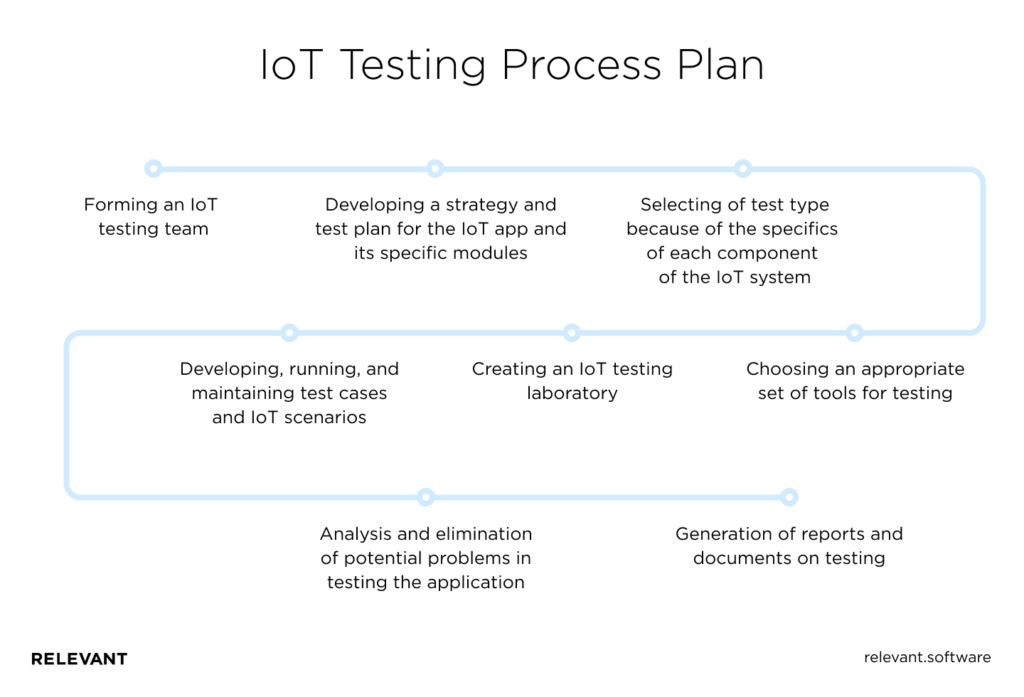
IoT system test protocol
The technical characteristics of IoT devices and problems with the devices and their firmware can interfere with the normal operation of the application. When we discover such issues during testing, we share our findings with clients and recommend changes.
The client changes something in his device and sends us requirements for changing the software. These changes require repeating the regression testing step to ensure that the entire system functions as expected, even after upgrades.
Standard IoT testing involves the next stages:
Component check
We check such components:
- Network connectivity.
- Software applications.
- Built-in sensors.
- Hardware devices.
- Security systems.
- Server or cloud infrastructure.
Functionality check
The IoT system should only respond and function as required. In addition, each connected device must communicate adequately. To do this, we test:
- Exceptions and errors.
- Communication between devices.
- System response.
- Calculation results.
Conditions check
Testing carried under the maximum conditions. In addition, IoT testers have saved the responses of the IoT system in the following formats:
- Automated conditions.
- Manual conditions.
Performance check
We calculate the performance of an IoT system based on the following components:
- System health to failure occurs.
- Data transmission frequency.
- Device performance.
- Synchronization.
In the end, we provide comprehensive reports on identified vulnerabilities, tools and methods used to exploit system flaws, and recommendations for eliminating identified risks.
IoT software testing best practices
And now, we will give you some valuable tips for testing smart device applications to avoid common pitfalls regarding their performance.
Automate mature testing processes
Because of the increased speed of R&D and the need to go to market first, it makes sense to automate some repetitive processes. However, automation requires not only the right technologies and tools but also highly qualified specialists. The best way is to automate only mature processes, particularly those that will provide a high return on investment.
Use the possibilities of cloud services
By leveraging the power of cloud computing, you can simulate high loads on IoT applications and check how they react to large amounts of data. In addition, the method helps check the data amount sent by the IoT application to the hub, especially when the IoT devices are in a low power state. This point requires special attention from the QA side since it is an excellent indicator of the quality of IoT applications for users.
Ensure usability and safety
If the device has a built-in payment option, then it should be fast and secure. In the event of a loss of a wearable device, the user should lock the smart device through their mobile devices or IVR.
Testing IoT systems is not an easy task, and competence in this area matters. As an IoT software company, Relevant has this expertise and can test usability, security, performance, connectivity, and compatibility in:
- Mobile applications (supported on Amazon, iOS, Android, Windows platforms);
- Device firmware;
- Integration of equipment and mobile devices (BLE, Wi-Fi sync);
- API (sync and store data between cloud and mobile app or hardware device);
- Data security – authorization and authentication protocols (token-based, key-based, OAuth), role-based access (client, API), XSS / SQL injection (manual), cache storage security (keyboard, browser, app).
We are flexible in choosing and changing the types of software testing within the project. Our QA team can uncover the perfectly hidden problems of your product. So, if your IT team lacks the resources to test an existing IoT system, or you need to develop and test a new IoT solution, Relevant is here to help.
IoT Testing is a series of QA tests to ensure that an IoT device’s performance, functionality, and security comply with standards. IoT application testing ensures that each device is fully functioning, works efficiently, and delivers the expected results.
Reliable IoT testing ensures system predictability and prevents unexpected failures. You can easily identify weak nodes in the network in advance and take measures to improve the system’s reliability.
Testers use various tools to test IoT systems. They are divided into two categories: hardware and software IoT testing tools. IoT testing tools for hardware testing – JTAG Dongle – Digital Storage Oscilloscope – Software Defined Radio IoT testing tools for software testing – Wireshark – Tcpdump – Shodan
When outsourcing software development, you need to study the portfolio, the case studies, the reviews, and the ratings of various IoT testing firms and only then proceed to the direct discussion of the desired services. IoT connected device testing services can be provided by: – Software testing companies have testing experience, but the Internet of Things isn’t their only specialty. – IoT consulting companies that offer end-to-end services (for example, IoT mobile apps development).
Your Next Read
How IoMT (Internet of Medical Things) Transforms Healthcare Industry
IoT Software Development Services
How to Hire an IoT Developer: IoT Developer Salary, Job Description
Success cases
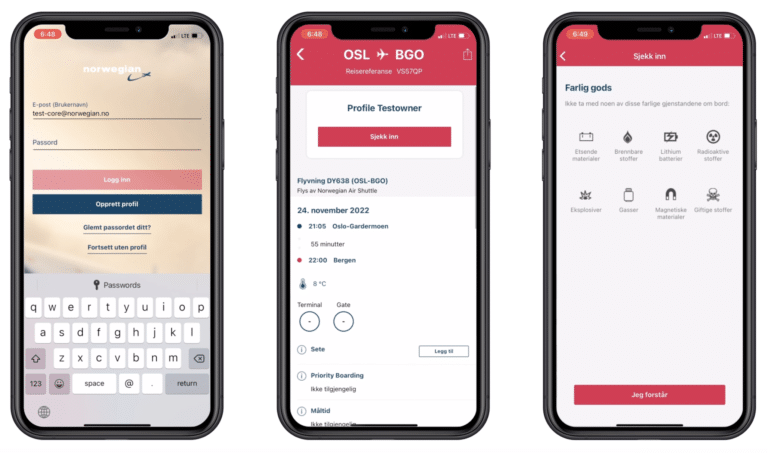
projects delivered remotely
of a team senior and middle engineers
employee turnover rate
customer satisfaction score

Our core services:
Do you want a price estimate for your project, hand-selected developers to fit your needs at scale.
- 200+ projects delivered remotely
- 7 years of software development expertise
- 92% of a team – senior and middle engineers
- World-class code quality delivered by Agile approach
Contact us to get the following:
- Price estimation
- Time to delivery
- Recommendation on tech stack
Get a quote

Privacy Overview

Do you know that we helped 200+ companies build web/mobile apps and scale dev teams?
Let's talk about your engineering needs.

We use cookies to improve our site and your experience. By continuing to browse our site, you accept our cookie policy. Read more. I understand
Customer log-in
- Get a trial
- 中文 (Chinese)
- 한국어 (Korean)
- 日本語 (Japanese)

IoT Case Studies
Explore our IoT case studies and learn how our customers have leveraged IoT connectivity to gain a competitive edge and create one-of-a-kind experiences.
Featured IoT Business Cases
{{post.post_title}}, no posts found. try to change filter, follow the iot pioneers.
For two decades, we have helped leading companies succeed with pioneering IoT solutions. In these IoT use cases, learn more about their strategies, and how you can succeed with connected products.
Outsource specialized knowledge and focus on your customers
Reduce vendor complexity with one partner for global connectivity, mitigate risk with guaranteed service levels and data security, speed up time to market with help from an experienced partner, gain peace of mind with a top rated service team on call 24/7.
Successful global IoT deployments require pioneering IoT solutions. Gain insights here on how connected products unlock value and deliver a competitive edge in these comprehensive IoT business cases.
We are working with many verticals. You can read detailed IoT case studies with global managed connectivity solutions for verticals such as smart cities, utilities, automotive, and industrial manufacturing, as well as transport and logistics.
More IoT Cases and Examples
15 iot examples for business applications.
When Sony proposed mSafety with connectivity from Telenor IoT, we seized the opportunity based on LTE-M's connectivity and battery life benefits. It is also very important that our connectivity provider has global roaming capabilities. LTE-M is the state of the art, offering carrier-grade machine-to- machine network connectivity.

We were looking for a partner to provide plug & play global connectivity. Telenor IoT has also guided us with technical decisions. Overall, this has helped focus our development resources to deliver a world-class application for our customers. Trusting Telenor's robust global connectivity is important for our application.

Telenor IoT are the backbone of our operation and have been our partner from early scale-up through to today. We selected Telenor IoT as our global connectivity partner, because they had the best performing SIMs and have proved to be trustworthy partners. Their global managed connectivity is reliable and secure which is critical.

Our target market is global customers who want the best-of-the-best. Telenor IoT was the obvious choice for connecting our cars, with their broad and extensive experience in connected automotive solutions. Also, their technical expertise and ability to trouble-shoot is industry-leading.

As industry leader, partnering with Telenor IoT has enabled us to move into new markets with comparative ease. Their support and troubleshooting tech team is world-class and when we need them, they are always available for questions and support.

Resources & News

Can Commercial Testing Automation Tools Work for IoT? A Case Study of Selenium and Node-Red
Ieee account.
- Change Username/Password
- Update Address

Purchase Details
- Payment Options
- Order History
- View Purchased Documents
Profile Information
- Communications Preferences
- Profession and Education
- Technical Interests
- US & Canada: +1 800 678 4333
- Worldwide: +1 732 981 0060
- Contact & Support
- About IEEE Xplore
- Accessibility
- Terms of Use
- Nondiscrimination Policy
- Privacy & Opting Out of Cookies
A not-for-profit organization, IEEE is the world's largest technical professional organization dedicated to advancing technology for the benefit of humanity. © Copyright 2024 IEEE - All rights reserved. Use of this web site signifies your agreement to the terms and conditions.
- Data Center
- Applications
- Open Source

Datamation content and product recommendations are editorially independent. We may make money when you click on links to our partners. Learn More .
When decision-makers consider implementing Internet of Things (IoT) solutions, they typically want assurance that their investments will pay off and that service providers’ offerings will meet or exceed their needs.
Reading IoT case studies can show business leaders what’s possible and help them make more confident choices about when and how to implement the technology.
These studies below show how the IoT opens diverse possibilities for businesses, helping them meet current and future goals.
See more: The Industrial Internet of Things (IIoT) Market
5 IoT case studies
1. improving insights at a vineyard.
Industry: Agriculture
Use case: Applying the IoT and data analytics to track statistics from fields and equipment across the complete grape-growing process.
Outcome: Deep Sky Vineyards has locations in Arizona and Argentina. Business leaders wanted a better way to oversee operations after a broken valve caused a flood. The company used a Google Cloud IoT solution that caused a 75% reduction in human error costs. Since the technology gives water flow and soil moisture metrics, it raised crop efficiency by 50% by preventing adverse conditions that could cause rot.
Cloud technology also allowed pushing over-the-air updates to remote devices. That convenience allowed the vineyard to maintain visibility over its sites and use the latest software versions.
2. Streamlining Contactless COVID-19 Testing
Industry: Health care
Use case: Building pods for contactless COVID-19 testing
Outcome: As the coronavirus spread around the world, it became critical to care for people without putting providers at unnecessary risk. For example, one Italian hospital used robots to take patients’ vitals. In this IoT case study, Microsoft Azure’s cloud and IoT solutions allowed for creating contactless testing stations in less than two months.
The solutions served as stations where people could drive or walk up to a window for their tests. The portability allowed setting up testing centers in remote locations or anywhere they’d most likely reach the most at-risk groups.
The testing pods have computerized translation services to help non-English speakers as well as artificial intelligence (AI) cameras that ensure everyone wears masks.
IoT innovations: 85 Top IoT Devices
3. Minimizing Labeling Errors During Automotive Production
Industry: Manufacturing
Use case: Using smart cameras and machine learning (ML) to help team members apply the correct regulatory labels to vehicles in a factory.
Outcome: Since the IoT can alert people to issues before they cause outages , manufacturing and industrial brands are particularly interested in its potential. It can bring attention to faulty equipment and also reduce human errors. Brands under the Volkswagen Group umbrella must apply 25 different labels during vehicle production, and each one has more than 2,000 variations based on country specifics.
Amazon Web Services (AWS) provided a cloud-based IoT solution that uses machine learning, automated cameras and IoT apps to identify label errors and alert workers to the issues.
The labels are in several languages, but this method translates them into an employee’s native tongue. Volkswagen Group representatives reported that this process improvement reduced the complexity of workers’ tasks and led to an overall improvement in vehicle quality.
4. Enhancing the Management of Solar-Powered Trash Receptacles
Industry: Waste management
Use case: Using IoT and the cloud to improve oversight of solar trash cans in a given location or community.
Outcome: BigBelly Solar relied on Telit to develop a better way for people to manage waste disposal points. This IoT case study caused an 80% reduction in management costs and gave customers a browser-based console for better visibility. The associated cloud functionality also facilitated remote diagnostics if a particular trash can malfunctioned in a customer’s network.
Moreover, an authorized party could use the cloud interface to remotely update a garbage receptacle’s software, keeping it functioning smoothly. BigBelly Solar has compacting and non-compacting versions. This technology works with both kinds to verify the fullness level of a given container, saving waste managers from having their staff members make unnecessary trips to check it.
5. Narrowing the Digital Divide to Facilitate Learning
Industry: Education
Use case: Bringing reliable internet access to the 70% of students in a Texas school district who did not have it at home. This approach also created secure outdoor access points.
Outcome: The COVID-19 pandemic caused a quick shift to remote learning for many students around the world. This IoT use case involved using products from Cisco’s IoT line to extend the school’s internet access into the homes of children who needed it to continue their studies.
After first testing this method by bringing dependable, private Wi-Fi to one cluster of houses, the school district’s leaders decided to roll out the technology to eight other groups of residences in the area. The people who worked on this project are developing a blueprint for use across the country, helping kids connect beyond the COVID-19 pandemic.
Oscar Rico is the school district’s executive director of technology. He explains his drive to find a solution, saying, “When your family can afford internet, you can get up, log in, and do your schoolwork from home. But 70% of our students don’t have internet access at home. Maybe some have access to a parent’s cell phone with unreliable internet. But I knew most would be sitting at a makeshift desk, working their way through a pile of paper. I wanted to find a way to change that.”
See more: Best IoT Platforms & Software
Subscribe to Data Insider
Learn the latest news and best practices about data science, big data analytics, artificial intelligence, data security, and more.
Similar articles
8 best network monitoring tools of 2024 (free & paid), crm software examples: 10 industry use cases and tools for 2024, coursera: machine learning (ml) courses for certification in 2024, get the free newsletter.
Subscribe to Data Insider for top news, trends & analysis
Latest Articles
8 best network monitoring..., what is cybersecurity definitions,..., crm software examples: 10..., coursera: machine learning (ml)....

IoT in Manufacturing: Top Use Cases and Case Studies
Updated May 17, 2021
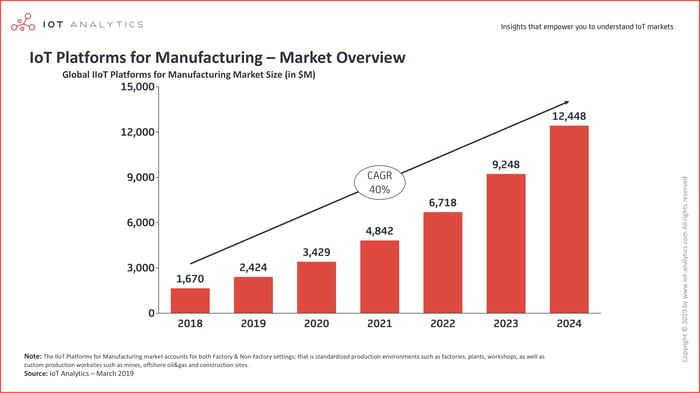
Within this article, we’ll be discussing practical IoT applications in manufacturing and use cases of industrial IoT technology in manufacturing
What is IoT?
What is iiot, the benefits of iot in manufacturing.
IoT represents a digital transformation in manufacturing processes and business operations. Using it alongside an advanced machine data platform can be transformational. And there are many benefits of IoT in manufacturing:
Process Optimization
Inventory Management
Predictive Maintenance
IoT in Manufacturing Use Cases [+Case Studies]
Remote monitoring.
Learn more about remote monitoring for machine builders and OEMs.
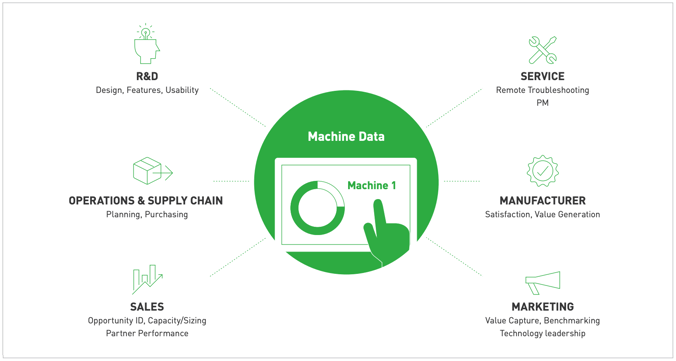
Supply Chain Management and Optimization
- Real-time tracking of assets and products
- Automation of warehouse tasks
- Digitized paperwork management
- Forecasting accuracy improvement
- Greater control of inventory
Digital Twins
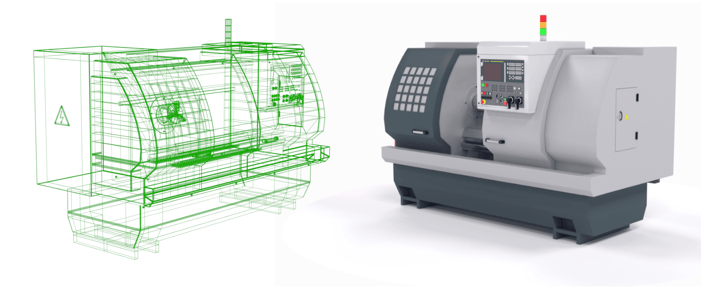
Real-Time Machine Monitoring
Production visibility.
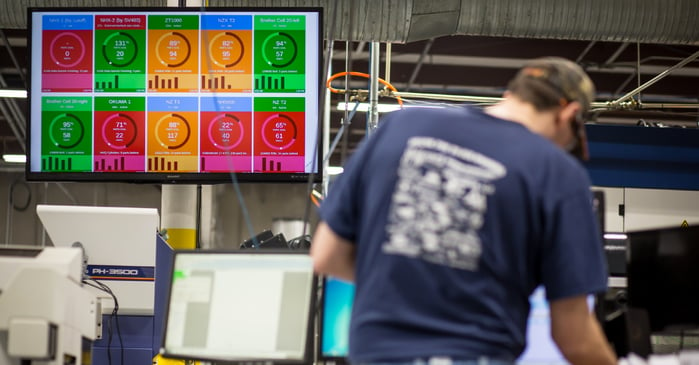
Integrating Systems
Compiling kpis.

Asset Utilization
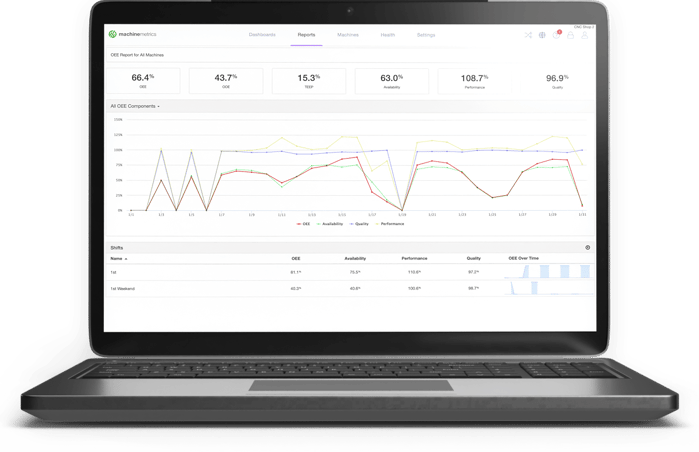
Difficulties of Adopting IoT in Manufactur ing
1. large investments are required and the roi is questionable, 2. concerns about data security, 3. employees who aren’t qualified, 4. integration with operational technology and older systems, how to use iot and machine data for remote operations, boosting your operational efficiency with iiot, subscribe to our mailing list, related posts, read the latest.
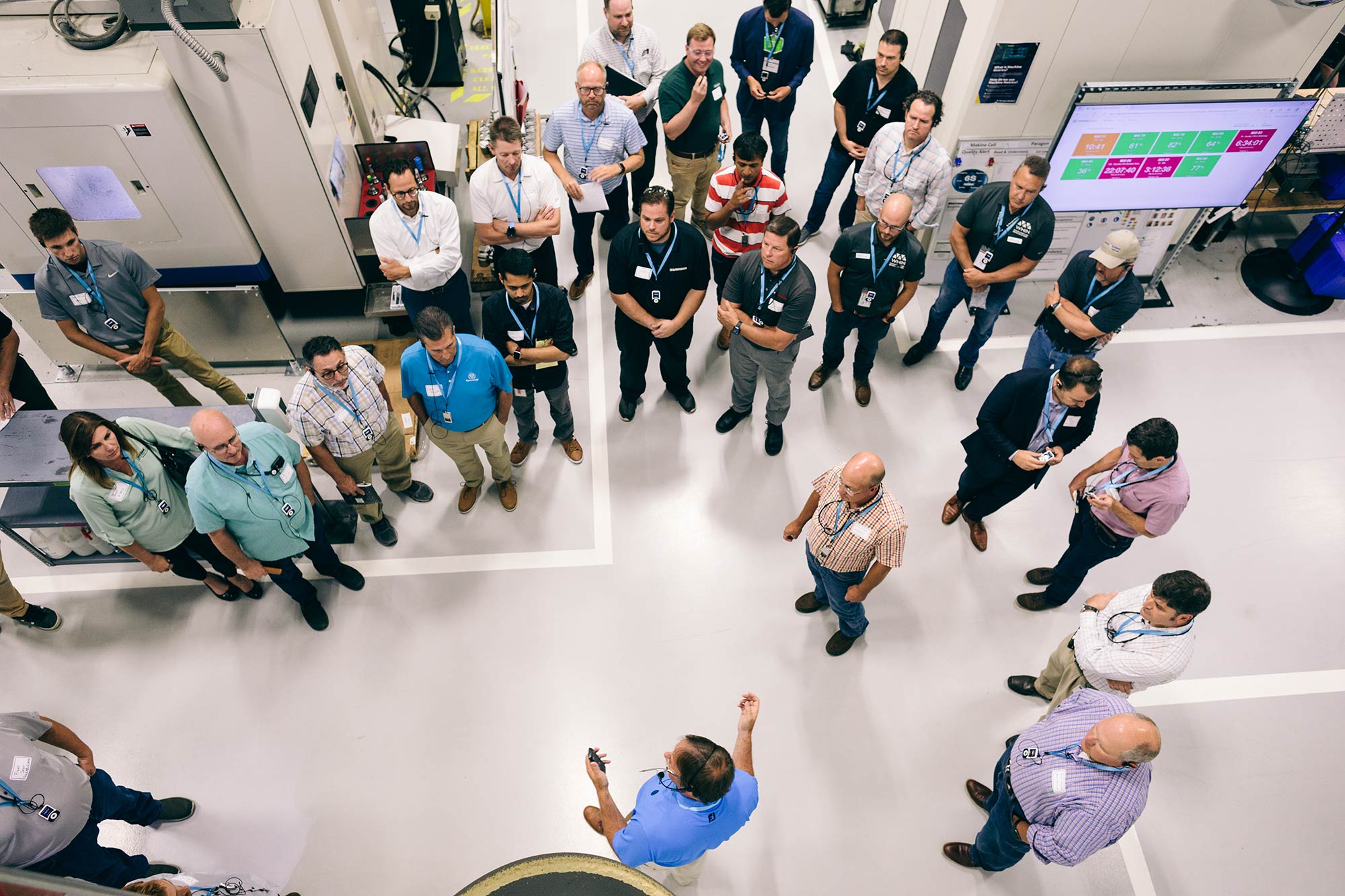
Lists by Topic
- MachineMetrics (381)
- Lean Manufacturing (72)
- Industry 4.0 (50)
- Manufacturing data (23)
- Manufacturing News (20)
- Data Science (15)
- data collection (14)
- Product Updates (12)
- manufacturing analytics (10)
- Connected Factory (9)
- Machine Monitoring (9)
- Smart Manufacturing (9)
- industrial iot (9)
- CNC Machines (8)
- Productivity (8)
- Downtime (7)
- Industrial Automation (7)
- Tool Monitoring (7)
- Big Data (6)
- Data Visualisation (5)
- Edge Computing (5)
- Maintenance (5)
- Process Optimization (5)
- Shop Floor (5)
- digital manufacturing (5)
- Automotive (4)
- Machine Learning (4)
- Quality Assurance (4)
- Aerospace and Defense (3)
- Contract Manufacturing (3)
- Data Cleaning (3)
- Death of MES (3)
- Heavy Machinery Manufacturing (3)
- MES software (3)
- Medical Device Manufacturing (3)
- OEE Software (3)
- Oil and Gas Manufacturing (3)
- capacity (3)
- continuous improvement (3)
- inustrial IOT (3)
- preventative maintenance (3)
- security (3)
- 8 wastes (2)
- Condition Monitoring (2)
- Dashboards (2)
- Internet of things (2)
- Strategic Partnerships (2)
- management (2)
- press release (2)
- real-time analytics (2)
- Digital Transformation (1)
- Downtime Categorization (1)
- FANUC FOCAS (1)
- Line Balancing (1)
- Machine Tool Distributors (1)
- Machinery (1)
- Manufacturing Innovation (1)
- Production Monitoring (1)
- Production Scheduling (1)
- Quality Control (1)
- Supply Chain (1)
- Turnkey contracts (1)
- coaching (1)
- elon musk (1)
- employee engagement (1)
- link roundup (1)
- manufacturing (1)
- manufacturing software (1)
- networks (1)
- release notes (1)
844-822-0664
Easthampton Office
116 Pleasant St, Suite 332, Easthampton, MA 01027
Edge Platform
Cloud Platform
APIs & Applications
Production Monitoring
Condition Monitoring
For Machine Builders and Distributors
For Developers
Aerospace & Defense
Contract Manufacturers
Heavy Machinery
Medical devices
Oil & Gas
Precision Metalworking
ERP Integration
Metal Stamping & Fabrication
Tool, Die & Mold CNC
ROI Calculator
Waste Calculator
Connectivity Hub
Partner Program
Privacy Policy
Data Processing Addendum
Service Level Agreement
Website Terms
- Performance Testing
- Functional Testing
- Quick QA For Startups
- Expert Corner
Case Studies
Iot product testing of smart nursery app, type of testing1, device testing, type of testing2, integration testing, smart nursery monitoring system, project management, jira, microsoft teams, the babysense smart nursery app encompasses three devices, each equipped with associated hardware. these devices were seamlessly paired with the app through bluetooth technology. the integrated hardware components encompass sensors, light and sound generation facilities, and a camera, all controllable through the application. hisense sought an adept testing team with experience in iot product testing to help in validating the functioning of the application along with the connected hardware devices within the iot system., lack of in-house testing team:.
Hisense lacked an internal QA team for effectively managing testing efforts. Software developers executed software testing without the perspective of an effective testing approach, that only proficient and experienced software testing professionals could provide. Hisense sought software testers with experience in IoT product testing to conduct comprehensive end-to-end product testing of their in-house developed IoT product and to validate the connectivity and the subsequent functioning of the devices and the software within the IoT system.
Hardware-Software Integration Testing:
Hisense was in search of expert software testers experienced in testing mobile apps integrated with hardware devices on both Android and IOS platforms. The application was integrated with three different devices using bluetooth technology: Babysense Connect, Babysense Dreamer, and BabysenseSee HD. The application testing was to be carried out for all these integrations on both Android and IOS-based mobile devices.
Required Standard QA Documentation:
The lack of timely updates to project documents following changes in various functionalities and features of the application posed a challenge for Hisense's software developers during testing. Many functionalities and features present in the application were absent from the existing project documents. Additionally, the functioning of some features did not align with the specifications outlined in the documents.
As the application became integrated with hardware devices, our software testers adopted an integrated testing approach to assess the functionality of both the application and the connected devices, including their connectivity. Thorough examination and documentation of the various features associated with the connected devices were conducted to formulate test cases that comprehensively evaluated the connectivity.
Planning and documentation:.
Initially, test plans were created based on the design document provided by Hisense. Test cases were then developed and executed according to the scenarios outlined in the design document. During testing, our testers identified mismatches between the operations of certain application functionalities and their descriptions in the design document. Some functionalities present in the application were found to be missing from the design document. Following the testing phase, our software testers collaborated with Hisense to update the design document based on their findings. This collaborative effort resulted in the creation of a comprehensive document, encompassing all the functionalities present in the application. The finalized document proved to be highly beneficial for the client in later stages.
Diverse Testing Methodologies:
Software Testers from Testvox carried out Functional testing, Smoke testing, Sanity testing and Regression testing on the application. Our software testers conducted End-to-End IoT testing on the application integrated with the hardware components of the three connected products on both IOS and Android based mobile devices through Bluetooth pairing , uncovering defects in the application during test case execution. This also included testing the variety of features associated with the connected devices like temperature display, time display, light and sound settings, ambience settings, etc. The testing process also included execution on the production environment to ensure thorough evaluation and good user experience.
Comprehensive Testing and Issue Reporting:
Testvox conducted comprehensive testing of the application according to the refined document, verifying various functionalities through their associated connectivity with the IoT hardware devices using bluetooth. For IOT testing on the application, a variety of mobile devices using both IOS and Android platforms, predominantly used by end users, were carefully selected. Real-time scenarios were simulated by employing the application and the three connected devices to assess the control functionality of these devices through the application. Any issues identified during testing were promptly reported to the development team to ensure swift resolution. Bug reporting and tracking were facilitated through Jira, while daily communications were seamlessly conducted using Microsoft Teams.
The initial assignment was for a period of 2 months. During this short duration, Testvox, with its team of software testers, executed testing services that left Hisense greatly impressed. In light of the positive outcomes and as additional functionalities were incorporated into the system, Hisense has been continuously engaged in testing which persists to date.
Software Testers from Testvox created and executed more than 300 test cases to conduct a comprehensive testing of the application.
The timely testing and feedback provided by Testvox's software testers significantly contributed to a substantial reduction in the time required to complete the product development.
Increase in efficiency
The application's efficiency increased fivefold after the successful completion of its testing.

Chime in on some Testing updates here

Accelerating Mobile App Testing With Testvox's Smart Automation Framework

Arabic Usability Testing By Testvox_UAE

Key Parameters for Selecting the Top Software Testing Companies in INDIA

Huwai App Testing Service By Testvox_UAE

Microsoft Dynamics 365 Testing Company in Dubai

Top 5 Freelance Websites For Hiring Software Testers In UAE, Dubai, And Abhudabi

Connecting Software QA Enthusiasts: A Revolutionary Campaign by Testvox

Odoo testing service company in Dubai, UAE
IoT Applications in 2024: 30+ Use Cases
Internet of Things (IoT) applications are becoming more widespread. According to Statista , worldwide expenditure on IoT in 2022 is expected to be $1B.
IoT enables a myriad of different business applications. Knowing those IoT examples and use cases can help businesses integrate IoT technologies into their future investment decisions. That is why we set out to create the most comprehensive list of IoT use cases in industries.
The image below shows the potential impact of IoT technologies in various industries in 2025.
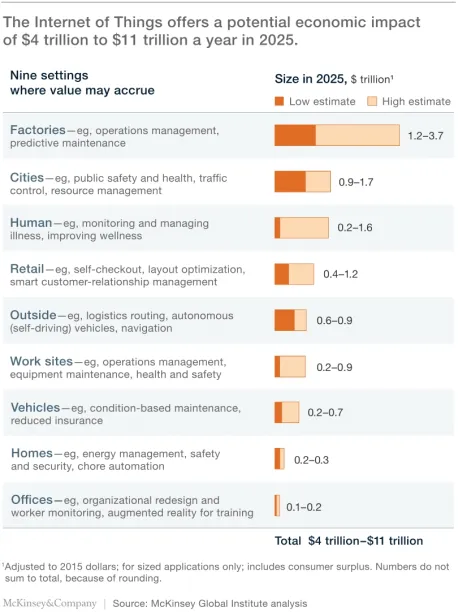
We have compiled 33 IoT applications for business leaders to select the correct use case for their IoT implementation . Use cases include:
Smart Factories
1. enterprise asset management.
Enterprise asset management involves work management, asset maintenance, planning and scheduling, supply chain management, and environmental, health, and safety (EHS) initiatives. Businesses collect real-time data from an asset with IoT sensors.
Businesses are rapidly adopting smart asset management systems into their businesses. Due to their asset-intensive environments, we mostly encounter IoT asset monitoring in industries such as logistics, retail, and manufacturing.
IoT-powered asset management increases real-time visibility of assets and helps businesses optimize their resource while providing benefits such as:
- Increased operational efficiency
- Better control over the sales lifecycle
- More efficient safety and compliance checks
- More responsive smart environment.
2. Predictive maintenance
Maintenance is conducted to prevent predicted problems. So over the lifetime of a machine, some components may never be checked if they are not predicted to cause problems.
For example, Fanuc is a robotics company that is working on reducing the downtime of machines with IoT technology. Fanuc uses sensors to predict when the failure of the component will happen.
3. Industrial process automation/optimization
Organizations can keep a real-time record of the metrics of all the machines inside a plant using IoT and IP networks. Manufacturers can use this data to automate workflows and optimize production systems. Automation and optimization support industrial companies to reduce costs and increase the quality and volume of output.
The market for automated industrial robots is proliferating. The market size was 41 billion U.S. dollars in 2017 and is expected to reach 73 billion U.S. dollars in 2023.
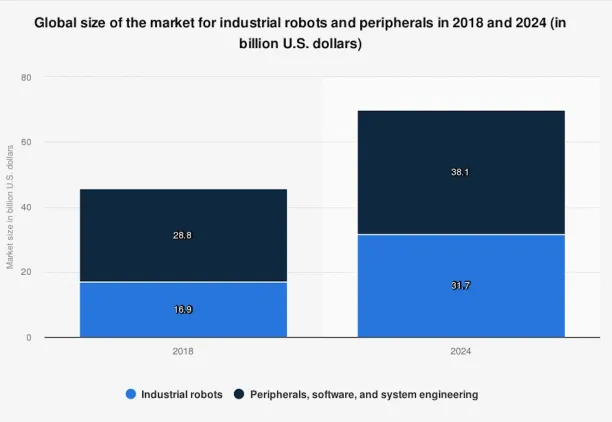
4. Energy management
Energy can be a costly input for industrial businesses. With fluctuating energy costs and strict government requirements for efficiency, managing energy distribution becomes important.
IoT devices can help manufacturers manage energy consumption based on real-time data collected from devices. Intelligent energy management systems reduce energy bills, operational expenditures, and the carbon footprint of the factory while increasing energy efficiency. WebNMS is an IoT platform that provides IoT applications including energy management to optimize the energy consumption of businesses.
Smart Cities
Kay Sharpington from Gartner, states “The COVID-19 pandemic is slowing down spending, however, governments across the globe continue to use IoT technologies and solutions to improve citizen safety. At the same time, the falling endpoint and connectivity costs make smart city initiatives more viable”.
Gartner estimated that the global government Internet of Things (IoT) endpoint electronics and communications market totaled $15 billion in 2020, an increase of 6% from 2019. Same study also reveals the top 5 government IoT applications and revenue generated by each use case as seen below:
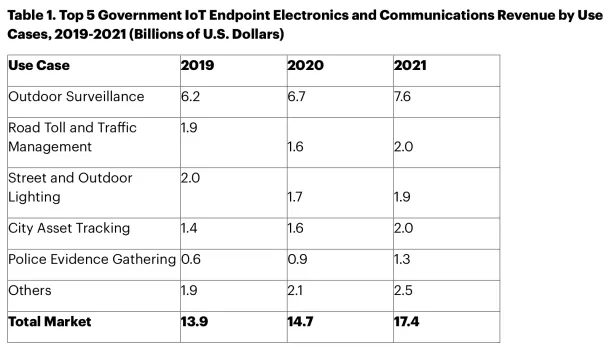
5. Outdoor surveillance
When IoT CCTV cameras are combined with artificial intelligence and machine vision, governments can automate the surveillance of streets through cameras. As IoT enables connectivity of machines, they can record and analyze video data in real-time, and they can provide police officers with insights instead of single pieces of images.
However, outdoor surveillance processes personal information and there is potential for abuse in the use of such technologies. Therefore appropriate checks and balances need to be implemented in such systems to ensure that personal information is not abused while the risk of crime is minimized.
6. Smart lighting
According to the 2018 Gartner IoT hype cycle report, smart lighting is the fourth-most mature IoT tech application. Smart lighting aims to optimize energy management.
Smart lighting is made up of street lighting with IoT sensors. Sensors collect data about the condition of traffic and pedestrians. With that data, street lights provide optimum lighting so that street lighting systems can save up to 80% of the energy.
Smart lighting can also be applied to factories or homes.
7. Electronic road toll collection and traffic management
Traffic engineers augmented by smart systems at a central traffic management center (TMC) can analyze data from IoT sensors and then optimize the timing of traffic lights throughout the day. This can help divide the traffic more evenly over roads as traffic volume fluctuates.
8. Smart parking
In cities like San Francisco, parking is a big problem. With IoT sensors, parking problems in a city can be minimized.
The working principle of smart parking is:
- Sensors are attached to parking lots to detect parked cars
- Measurements are periodically sent to the cloud by microcontrollers
- Mobile Apps use cloud data to identify empty parking spaces,
- Drivers check mobile apps to identify vacant parking spaces close to the location they aim to go to.
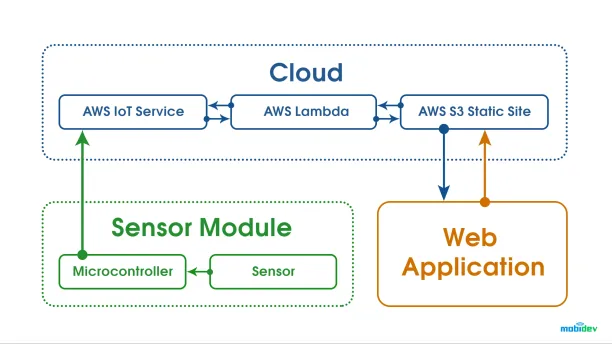
Noise Monitoring
In smart cities, sound monitoring systems can monitor noise levels warn companies that violate limits, and help manage noise levels.
9. Structural health monitoring
IoT allows remote collection of architectural data to monitor events such as vibrations and changes in material conditions, predict structural damage, and prepare action plans for structures such as bridges, buildings, stadiums, ships, airplanes, etc.
10. Waste management
Traditional waste collections are complicated and costly since a fleet of trucks drives along busy streets using inefficient routes. Fill levels of garbage containers differ for each container: ranging from overflowing, partially filled, and empty. IoT sensors can monitor fill levels for conventional bins and send the data to the relevant department of the city hall. With that information, the garbage truck routes can be optimized for trash collection.
Machine learning methods can also be implemented in IoT sensors (i.e. edge analytics ) so that sensors can predict the fill levels of containers by learning from historical data.
Below the video, you can find how Proximus, an IoT solutions vendor, uses IoT to manage waste:
Water Management
Due to the drastic increase in urbanization levels and the importance of water quality in human health, water management is a key topic for cities. A water management system is based on real-time data collected from sensors. Water management can provide the following applications:
11. Water conservation
Sensors detect the water level in tanks and alert when the water level is lower than the threshold. Well™, a smart home water conservation system developed by Mindtribe , uses IoT sensors to monitor water usage.
12. Smart irrigation
IoT sensors determine the weather conditions and the soil moisture, which will help in getting the appropriate amount of water that the soil needs. For instance, greenIQ is a vendor that offers a sprinkler sensor that optimizes its functionality based on the dryness of the soil.
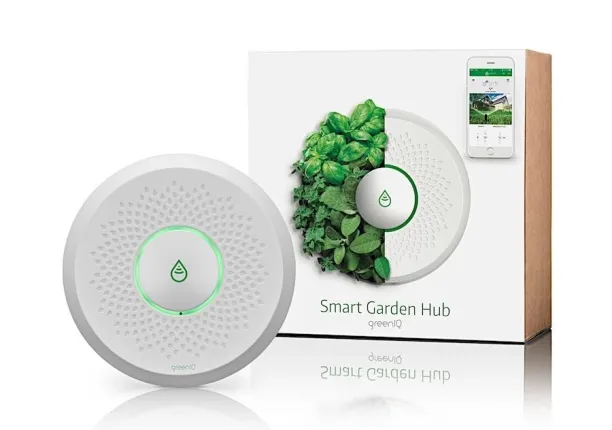
13. Leakage management
IoT sensors can detect temperature changes, water leakage, chemical leakage, and pressure levels in water tanks.
14. Water quality management
IoT sensors determine what kind of chemicals are in the water. They also identify metrics such as total dissolved solids (TDS), bacteria, chlorine, electrical conductivity, etc.
Learn more about IoT in agriculture.
Digital Health
15. ultraviolet radiation monitoring.
Sunlight consists of three major components:
- Visible light: Wavelengths between 0.4 and 0.8 micrometers,
- Ultraviolet light: Wavelengths shorter than 0.4 micrometers,
- Infrared light: Wavelengths longer than 0.8 micrometers.
Ultraviolet (UV) rays are electromagnetic waves that account for about 10% of solar light. When overexposed, UV rays have harmful effects such as skin cancer, premature aging, cataracts, and immune system suppression. IoT sensors measure UV sun rays to warn people not to be exposed during certain hours.
16. Fall detection
Falling to the ground and not being able to get up or request help can be a scary experience for senior citizens. IoT sensors can detect falls using geolocation data and summon help so that it reduces the time the elderly remain on the floor after a fall which could lead to lethal consequences.
The below video is an example of how fall detection systems work from a vendor called Walabot:
17. Companion robots
A companion robot is a robot that is designed to create companionship mostly for elderly and single children. IoT sensors are essential for robotics and it is the same for companion robots as well. Sensors detect objects that surround the robot and enable the robot to move.
Researchers claim that people have become more receptive to companion robots during the pandemic. Social isolation may lead people to loneliness, anxiety, and frustration, especially the elderly.
18. Medical fridges
Medical fridges monitor the temperature of vaccines, medicines, and organic elements for clinics and health centers. Medical fridges provide an opportunity to follow all safety standards and national regulations of the pharmaceutical market using IoT sensors. They prevent medicines and vaccines from spoiling.
Efento is an IoT sensor and IoT platform vendor that has a variety of temperature measurement products along with wireless monitoring of temperature in medical refrigerators.
19. Patient surveillance/remote patient monitoring
20% of patients who had surgery are readmitted to the hospital within just 30 days. Remote patient monitoring (RPM) systems use wearables to monitor the condition of patients who are resting at home after surgery. RPM enables real-time data collection about patients’ body temperature which is the main indicator of infections. With RPM, doctors can observe patients’ data and provide early diagnoses without requiring patients to be physically present at the hospital.
Telit is an IoT solution vendor and offers its customers a remote patient monitoring (RPM) solution that enhances patient monitoring capabilities and patient satisfaction. Telit’s offering can reduce:
- Patients hospital stay duration thanks to early diagnosis of complications
- Hospital readmissions
Smart Retail
20. supply chain control.
IoT devices have transformed supply chain management. Sensors, which are attached to storage containers or products themselves,
- show the location of goods using GPS,
- track the speed of movement providing an accurate estimated time of arrival (ETA) for goods,
- monitor warehouse conditions such as temperature, humidity, light intensity, and other environmental factors
21. Near field communication (NFC) payment
NFC enables contactless payments. POS vendors include NFC support in their systems, and customers are adopting contactless payments via their smartphones.
22. Layout optimization
Sensors in the store collect data like voice, image, or video to better understand customer habits and preferences. Retailers can get insights to redesign the layout of their stores. The optimized layout can enhance sales.
23. Smart product management
IoT sensors enable retailers to control the rotation of products on shelves and warehouses to automate merchandising decisions. We have already written about retail analytics use cases, feel free to check it out if you want to learn more.
Smart Workplace
24. sociometric badges.
Sociometric sensors are wearable IoT devices that measure the amount of face-to-face interaction, conversational time, physical proximity to other people, and physical activity levels using social signals derived from vocal features, body motion, and relative location.
For example, Humanyze is a vendor that uses sociometric sensors to perform people analytics. The company helps organizations understand how their teams interact to increase performance.
Smart Homes
25. remote control appliances.
IoT-powered home appliances let residents remotely switch on and off devices using smartphone apps to avoid incidents and save energy. Additionally, these devices can make autonomous decisions based on sensor inputs such as preparing fresh coffee when a resident is identified to wake up. Other examples of autonomous or remote-controlled actions include:
- Turning on lights,
- Starting the coffee maker,
- Setting temperature,
- Open up a music playlist,
- And locking doors.
Home Intrusion Detection Systems:
IoT-based home security applications give users capabilities such as smart locks and security cameras that detect motions and send alerts to their smartphones so that they can monitor the safety conditions of their homes from anywhere.
26. Smart locks
Eyelock is a security provider vendor that offers its clients an iris-based authentication solution.
27. Motion detection
Manything is another vendor in IoT IoT-based home security market. It streams home/office videos and lets users receive alerts when it detects any activity.
Smart Logistics
28. fleet tracking.
IoT fleet tracking systems improve security and provide precise and complete reports that give the fleet managers full transparency regarding the fleet’s activities. Through GPS monitoring and geo-location tools, companies can track the location of their trucks, optimize routes, and monitor their fleet utilization in detail.
For instance, Canadian delivery service Sure Track Courier saved 6-10% per month on fuel costs by optimizing routes using IoT data from trucks.
29. Platooning
Platooning involves a group of self-driving trucks that follow a lead truck at high speed safely and efficiently. Trucks use IoT sensors so that each truck communicates with the other trucks to adapt its speed and braking accordingly.
30. Connected vehicles
Sensors are enhancing vehicles along with AI and analytical capabilities. These sensors provide communication with the driver to supply useful information about other cars on the road and roadside infrastructure to the driver to help the driver make safer or more informed decisions. For example, these vehicles provide GPS-enabled location detection feature that helps them detect traffic congestion.
Autonomous vehicles are also an application of IoT devices. Though it is not commonly used in logistics yet, we will witness this approach soon. For instance, the Mercedes-Benz prototype of the semi-autonomous truck is scheduled for release in 2025.
Smart Metering
31. smart grid.
With the increasing attention regarding climate change and carbon emissions, utilities focus on reducing energy consumption. For utility companies, IoT enables remote data management and monitoring capabilities to manage better power flows into and out of their grids, and give users the insights needed to understand their energy infrastructure investments.
32. Digital Twins
A digital twin is a virtual replica of physical entities such as devices, people, processes, or systems that help businesses make model-driven decisions. With the help of IoT sensors, businesses collect data that is needed to create a digital twin.
Digital twins enable businesses to gain a deeper understanding of real-world conditions so that they make necessary adjustments to their products & services.
33. IoT devices in healthcare
In healthcare , the ecosystem of IoT-enabled devices such as wearables (smartwatches, rings, vests, etc.), monitors (heart monitors, sleep monitors, temperature monitors, etc.), and trackers (medication refill reminder, drug effectiveness tracking, etc.) can be used for:
- Constant monitoring of patients’ vitals (blood pressure, heart rate, temperature rate, etc.),
- And more accurate diagnoses of patients, thanks to real-time data from IoT devices, thus reducing the possibility of readmission and rising hospital bills.
Read more on IoT
We have written articles about IoT technologies before, feel free to read our other articles on:
- Increase Speed to Market Using an IoT Platform
- Edge Analytics in 2022: What it is, Why it Matters & Use Cases
- IoT Testing: Framework, Challenges, Case Studies & Tools 2022
We also have some in-depth articles on other use cases of IoT in different industries:
- Top 6 Use Cases of IoT in Manufacturing
- 5 Use Cases of IoT in Automotive in 2022
- 7 Ways IoT Will Improve Your Banking Experience in 2022
Finally, if you believe your business could benefit from implementing an IoT solution, we have a data-driven list of vendors prepared .
We will help you choose the best one for your business:

Cem has been the principal analyst at AIMultiple since 2017. AIMultiple informs hundreds of thousands of businesses (as per similarWeb) including 60% of Fortune 500 every month. Cem's work has been cited by leading global publications including Business Insider , Forbes, Washington Post , global firms like Deloitte , HPE, NGOs like World Economic Forum and supranational organizations like European Commission . You can see more reputable companies and media that referenced AIMultiple. Throughout his career, Cem served as a tech consultant, tech buyer and tech entrepreneur. He advised businesses on their enterprise software, automation, cloud, AI / ML and other technology related decisions at McKinsey & Company and Altman Solon for more than a decade. He also published a McKinsey report on digitalization. He led technology strategy and procurement of a telco while reporting to the CEO. He has also led commercial growth of deep tech company Hypatos that reached a 7 digit annual recurring revenue and a 9 digit valuation from 0 within 2 years. Cem's work in Hypatos was covered by leading technology publications like TechCrunch and Business Insider . Cem regularly speaks at international technology conferences. He graduated from Bogazici University as a computer engineer and holds an MBA from Columbia Business School.
To stay up-to-date on B2B tech & accelerate your enterprise:
Next to Read
Guide to iiot in 2024: 7 benefits, 3 challenges & examples, 30 internet of things iot stats in 2024 from reputable sources, iot testing: framework, challenges, case studies & tools 2024.
Your email address will not be published. All fields are required.
Related research
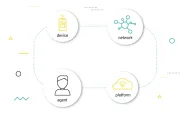
A 2024 Guide to IoT Ecosystem: 5 Components & 3 Challenges

IoT Cloud in 2024: Benefits, Challenges, Platforms&Functionality
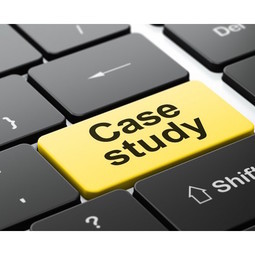
Your Guide to Writing Compelling IIoT Case Studies
Case studies are your primary tool for building trust and awareness in your iot solutions.
Published on 09/29/2016 | Market Sizing
Erik Walenza-Slabe
Erik walenza is the ceo of iot one, an information platform dedicated to mapping the industrial internet ecosystem. he chairs the smart factory task group of the industrial internet consortium. and he is the shanghai director of startup grind, the world's largest independent network of entrepreneurs., what’s in this guide for you.
Sales of Industrial Internet of Things (IIoT) solutions are constrained by a general lack of experience and credibility. Nobody wants to be the first user of a costly solution. You need to establish trust by demonstrating your ability to deliver solutions that provide an attractive ROI with an acceptable level of implementation risk. A case study's purpose is to court prospects, not praise past work. However, there is nowhere that evidence of successful past project is more valuable than in the Industrial IoT. This guide provides an overview for writing and broadcasting compelling case studies that will: - Demonstrate the kinds of problems you are good at solving - Highlight the unique capabilities of your solutions - Illustrate how your customers evaluated your performance - Show your ability to manage successful customer relationships - Provide quantitative proof of the value of your solutions You can tell your customers that you're great at X and that you're light-years ahead of the competition when it comes to Y and Z, but at the end of that day, that's just sales talk. What you need to win new business is cold, hard proof.
Step 1: Identify Use Cases that Your Ideal Customer Relates to
Case studies are success stories. Real IIoT success cases are rare, and for that reason potential customers value them highly. In order to provide your sales team with stories that will lead to project discussions, you need to have a definitive plan for identifying which stories your customers will relate to. There are 5 characteristics that may indicate a winning case study candidate: 1. Strong Relationships: The more a customer trusts you and your solution the better. This will help to ensure that they can speak to the value of what you offer with sufficient depth to make sense to potential customers. 2. Switchers: Conversely, customers that came to you after trying a competitor's solution can highlight your competitive advantages and provide an ideal storyline to explain how you differentiate. 3. Exemplary Results: IIoT solutions are about creating business value. You need to illustrate this value with real data. The customers that have seen the best results are going to contribute to the strongest case studies. Also, if their results are excellent it is more likely that they will agree to contribute to a case study for you. 4. Unexpected Success: The IIoT is a world of niches. Many of your potential customers could be non-traditional. Thus, non-traditional customers that have seen positive results can help to illustrate the value of your solution across a wide range of situations. 5. Recognizable Names: At the end of the day, decision makers trust brands. Small companies may have powerful stories, but leading brands will enhance the credibility of your case studies. To get the right case study participants on board, you have to explain 'what's in it for them'. As with any sale, this comes down to understanding how you can support their goals. Many companies (and professionals) want to brand themselves as IIoT thought leaders. This can be the starting point of your request since the case study features your customer as much as it features your company. To ensure smooth communication, you need to set expectations and determine a well-defined timeline. The primary reason that case studies are delayed is due to the customer not having a timeline or sufficient authorization to approve the case study. Make sure that you have covered all of the bases before you commit. To avoid a delay, you should kick off the process with an introduction email that explains expectations for both you and your customer. This could include: - A clear explanation of why you are creating this case study and how it will be used. - A statement defining the information you expect to include about the company -- names, logos, job titles, pictures, etc. - A summary of expectations, such as interviews to gather input into project results. - Identification of any compensation you plan to offer (such as perhaps a discount on future work).
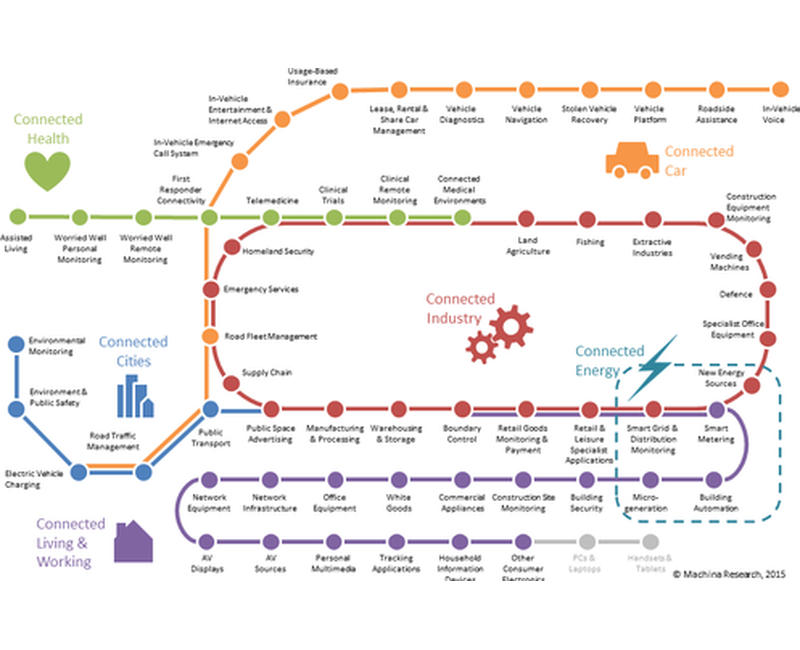
Step 2: Accumulate the Case Background, Data, and Customer Input
You case study needs three types of content, which should all be accumulated prior to drafting: a clear storyline, data that demonstrates value, and customer input that potential customers can relate to. Let's start with the storyline. There are four areas that are important to explain in any case study and two that are optional and contingent on your customer's willingness to share operational details: 1. The Customer: Your readers will better relate to the case study if they understand your customer's business. How long have you been in business? How many employees do you have? Which department was involved in the project? What were their priorities? 2. The Challenge: The solution is only valuable insofar as it addresses a real challenge. What challenges and goals led the customer to look for a solution? What would have happened if they did not identify a solution? 3. The Decision Process (optional): Understanding how the customer arrived at their decision helps to guide the decision-making process of potential customers. Did they explore other solutions prior to yours that did not work out? How did you hear about our product or service? Who was involved in the selection process? What was most important to you when evaluating your options? 4. The Implementation (optional): Focus on exploring their experience during the onboarding process. How long did it take to get up and running? Did the timeline meet expectations? Who was involved in the process? 5. The Solution: Help readers to better understand how the customer is using your solution. What are the software, hardware, and service elements of the solutions? Is there a particular aspect of the solution that your customer relies on most? Which departments are using the solution? 6. The Results: Illustrate impressive measurable outcomes using data. How has the solution helped to achieve your customer's goals? Which processes changed after implementation and how? How has your customer's competitive advantage been enhanced? How much have you improves metrics X, Y, and Z? Next up is data. After you have a firm outline, it should be clear which data you need to make your case. The challenge is generally in collection. Data can be collected during interviews, from customer databases via written request, or from your own databases if you are aggregating customer data. In the last case, it is very important that you ask for written permission to publicly disseminate the data despite the data that it already resides in your organization. However you acquire the data, you must make sure it is meaningful. Have you ever read a case study that claimed they “halved energy costs” for the customer and wondered if that meant they went from to $200 per month to $100 per month or $2,000,000 per month to $1,000,000 per month? Avoid ambiguous meaning. Use both percentages and real numbers (or at least magnitudes) to build credibility. Finally, ask the right questions to gather input your potential customers can relate to. Once you have a strong questionnaire template, a 60-minute interview (or a detailed written response) should be sufficient. The interview will illustrate your customer's experience with working with you. Set yourself up for success by asking the right questions. Here are a few winners to get you started: - What were your goals? Has our solution helped to achieve them? Please explain. - What challenges were you experiencing? How have your situation and processes changed following implementation? Please explain. - Why did our solution stand out against our competitors? What aspects have you found most valuable? Please explain. - How has this solution impacted your competitiveness as a company? Please explain. Whether you interview by phone, in person, or via a written questionnaire, I recommend that you follow the "Golden Rules of Interviewing" - Ask open-ended questions. Yes or no answers will not inspire potential customers. You need details to build credibility. This can be accomplished by including some variation of 'Please explain" at the end of every question. Remember, silence is your friend. People tend to fill a silence with details.
Step 3: Design a Well-Structured Case Study
A great case study is substantial but streamlined. It needs to communicate a lot of detail to a busy decision maker. Structure is key. There are two types of case studies, long-form and short-firm, and most companies should produce a mix of both. The format of a particular story will depend largely on how much detail the featured customer is willing to share. Long-Form Case Study - Frequency: Monthly or quarterly - Length: 1,000 – 2,000 words - Target persona: Decision makers, business managers, technical managers - Strategic focus: Aspirational; cutting edge projects that brand us as a leader Short-Form Case Study - Frequency: Weekly or monthly - Length: ~500 words - Target persona: Senior decision makers who will not read long-form case studies - Strategic focus: Representative; the kind of work we routinely do Regardless of the form, a compelling case study will include seven types of content. 1. Title: Keep it short. Highlight the most compelling accomplishment 2. Executive Summary: Summarize the customer, challenge, solution, and result in 3-4 sentences. Support this with 2-3 bullet points that display metrics showcasing success. 3. The Customer: 1 paragraph is generally sufficient. Avoid defining the customer too narrowly. You want other potential customers to see themselves in this case. 4. The Challenges: This section should include 2-3 paragraphs describing the customer's challenges and goals prior to implementing your solution. As with the customer, you want to ensure that your reader's associate with these challenges and goals. 5. The Solution: This section should include 2-3 paragraphs that focus on describing your solution, including the implementation process (if possible). 6. The Results: This section should include 2-3 paragraphs that prove how your solution impacted the person or company and helped them achieve their goals. Data and before-after comparisons are particularly convincing. 7. Supporting Visuals or Quotes: Use bullet lists, side boxes, and other design features to highlight several quotes and data visuals that support your storyline. After the case study is composed, send a draft to your customer to give them a chance to provide feedback. Once any necessary edits are completed, send a final version of the case study to your customer for final approval. After the case study goes live, send the link to your customer and any technology partners that were featured in the case study and ask them to share the link with their network.
Step 4: Catalogue Your Case in IoT ONE's Case Study Database
What’s the point of having great case studies if no one will ever read them? Be sure that your case studies are organized and easy to find. IoT ONE works hard to match the right audience and solution by categorizing case studies by: - Industry - Functional area (or department) - Enabled capability (i.e., what your solution enabled your customer to do) - Hardware, software, and service (across 21 categories) - Connectivity protocols (for companies that prioritize brownfield compatibility) - Vendors The process of uploading a case study to IoT ONE takes 5-10 minutes. The majority of the work involves simply cutting-and-pasting text or checking boxes. Here are the steps you will follow: 1. Signup: If you do not yet have an account, you can signup at www.iotone.com/signup . If your company does not yet have a vendor account, you can create one at www.iotone.com/vendor/add . This can be as simple as adding your company name, logo and website. However, we recommend that you take 5 minutes to create a complete company overview. 2. Upload New Case Study: You can upload your new case study through your Admin Panel or at www.iotone.com/casestudy/add . 3. Meta Tags: Make sure your case is searchable by selecting the relevant vendor name, industries, functions, capabilities, protocols, and technologies. 4. Description: Give your case study a title and overview description. 5. Benefits: Share how your solution benefited your customer. Under 'operational impacts' you can identify qualitative process improvements, and under 'quantitive benefits' you can identify improvements in metrics. 6. Technology: Use our lookup fields to link to any software or hardware solutions that were featured in the case study. You can also identify technology partners that you would like to highlight. That's it! We'll share your new case study to our audience of end users and IIoT solution providers over IoT ONE, Twitter, LinkedIn, and our newsletter. You can also broadcast your success by sharing the link with customers and partners.
Step 5: Visualize the Technologies Used in Your Case Study
While some people enjoy reading, others prefer a more dynamic way to explore a case study. We have recently launched the beta version of a dynamic, drag-and-drop tool call the IoT Playbook that will allow you (and your customers) to visualize solutions in practice. The tool's features will include: - Drag hardware and software from databases to build your visualization - Indicate compatibility between hardware components - Upload an image as the playbook background (ranging from legacy hardware, to a warehouse interior, to a factory blueprint, to a city map) - Allow your customers to create their own playbooks to explore how your technology can be used - Build playbooks in real time at sales meetings, or embed them in your marketing documents The system is currently under beta testing. I will update this post following launch.
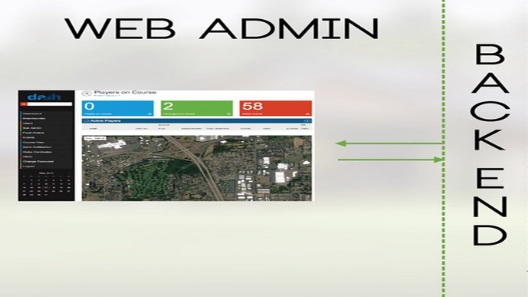

- Communications
- Energy and Utilities (E&U)
- Financial Services
- Healthcare & Life Sciences
- Manufacturing
- Media & Entertainment
- Retail and Ecommerce
- Travel & Hospitality
- Artificial Intelligence Testing
- Big Data & Analytics Testing
- Blockchain Testing
- Cloud Migration Assurance
- Security Assurance
- Internet of Things (IoT) Testing
- Mobile Testing
- Robotic Process Automation (RPA)
- 5G Assurance Services
- DevOps Testing
- Compatibility Testing
- Functional Testing
- Performance Testing
- Regression Testing
- Security Testing
- Test Automation
- Crowdsourced Testing
- Quality Engineering
- ERP Testing
- Salesforce Testing
- Medical Devices Testing
- Agile Testing
- Test Data Management
- Service Virtualization
- DevOps Transformation
- Test Center of Excellence
- Test Advisory & Transformation Services
- Build Operate Transfer (BOT) Model
- Programmatic Innovation
- Agile Transformation
- Software Product Engineering
- Application Modernization
- Blockchain Engineering
- Enterprise Application Development
- User Experience Engineering
- Site Reliability Engineering
- Data Insights
- AI & ML
- Verita – Quality Engineering Dashboard
- Velocita – Test Automation Accelerators
- Praxia – Process Accelerator
- MAP – Model Assurance Platform
- CLAP – Cloud Migration Assurance Platform
- iNSta – Intelligent Scriptless Test Automation
- Cesta – Integrated Migration Solutions
- Incight – App Experience Analyzer Tool
- Zastra.ai – Active Learning Driven Annotation Platform
- Performance Engineering Lab
- Robotics Lab
- IoT and Smart Meters Lab
- Case Studies
- Digital ARMER
- Digital Dialogues – Podcast
- Digital Dialogues – Webinars
- herDIGITALstory TM
- Newsletter – Cignizine
- Tech Briefs
- Testimonials
- White Papers
- Infrastructure
- Cigniti in the News
- Press Releases
- Board of Directors
- Board Code of Conduct
- Corporate Presentation
- Annual Reports
- Quarterly Results
- Shareholding Pattern
- Announcements
- Analyst Recognitions
- Cigniti Careers
- Campus Connect
- Alumni Relations
- Life @ Cigniti
- Diversity, Equity, and Inclusion
- Corporate Social Responsibility
- Sustainability
CASE STUDIES
Iot assurance with smartmeter lab & ami automation regression test suite helped an energy distributor achieve 100% functional test coverage.

Access to safe and reliable electricity has become imperative for our everyday lives. An Australia-based government-owned trading enterprise that generates, distributes, and retails electricity wanted to automate the maintenance of its smart meters to offer reliable services to its customers. Learn how Cigniti leveraged its IoT Assurance expertise, Smart meter labs, and AMI Automation Regression Test Suite to help the client achieve 100% functional test coverage.
Download the Collateral
Case Studies

- Test consulting & tools assessment partnership providing test assessment approach along with its in-house tools evaluation frameworks across various areas ❶
- Test advisory and managed testing of their new banking systems and integration testing for the complex touchpoints for multiple Fiserv products ❷
- Functional testing for MIFID II compliance across various systems including Charles River, Black Rock Alladin and Unavista. Set up a team of domain experts in quick time and help client complete the testing as per the regulatory deadline ❸
- Functional, usability and performance testing of new digital wallet services for quick financial transactions, and performed end-to-end testing of mobile app and APIs ❹

- Test partnership across all digital and backend applications for functional testing and tst automation. Setting up the QA processes, automation solution and framework from scratch and defined the automation roadmap ❶
- Functional and regression testing for existing ERP and web application. Development of automation framework and script to run regression suite. Refined overall testing process and implemented agile processes for both SDLC & STLC ❷
- Designed test strategy and performed functional and system integration tests across the application & UAT support was provided for supply chain, stores sales, and warehouses system ❸
Health Care

- Test partnership for automation, functional & performance testing services in a hybrid model across their information management system tested on both functionality and database end ❶
- End-to-end functional, security and performance testing of solution for defects in the application before going live. Setting up QA/ testing processes and creating re-usable test cases, etc. ❷
- Created performance test scenarios & automated critical test cases for strategy style maintenance & batch execution of automation scripts for desktop-based application ❸
- Performed VAPT on the web application, web services, AWS S3 buckets and medical device as per OWASP guidelines & SANS Top 25. Created HIPAA compliance policy manual for client & assisted with its readiness assessment ❹

- End-to-end functional testing partnership and provided agile coaching and streamlined their test processes. Supported system, data migration, and performance testing for ongoing sprints & support on regression, exploratory, integration, and automation testing ❶
- Test advisory, end-to-end functional testing, test automation, implement integrated automated testing framework, test optimization techniques & helped in setting up CI/CD pipeline. Streamlined IT processes and artifacts, optimized resource skills, tool metrics & provided well-defined quality management and monitoring mechanism ❷
- End-to-end validations on their IoT system. Performed component level and system-level tests using JMeter, Grafana, and Prometheus integration was implemented for component level and system-level performance, scalability, stress and endurance tests ❸
Media & Publishing

- End-to-end test testing function operating in an onsite/ offshore model. Services included test automation and performance testing. Reduced regression cycle time using automation first approach and helped identify the application bottleneck ❶
- Test automation partnership for their money control application based on web, desktop and mobile (both Android & iOS). Leveraged its in-house test automation framework Tx-Automate built on the BDD approach to help create an end to end CI/ CD testing framework integrated with client’s in-house DevOps tools ❷
- Performed integration, functional, usability & regression testing the application & customized QA process as per client needs to implement enforced standards and to build consistency across the teams ❸
- Conducted POC to identify a suitable performance testing tool for the application & recommended HP load runner, perform tool and using these testing was performed of a complex application ❹
ISV & Telecom

- Staffing & managing of QA testing team to support a host of different applications. Implemented matured agile transformation QA practice and extensive experience of test and lifecycle automation helping to build the right QA capabilities ❶
- Device testing for their mobile application based on iOS and android platforms over different physical devices. Determined the transparent data transmission in the devices connected via HFP ❷
- Test automation partnership for client’s software used for client lifecycle management processes. Leveraged Tx-Automate to enhance the solution and build a team to rapidly scale test automation for their key financial services clients ❸

- Test partnership for cloud transformation initiative including moving applications portfolio to Cloud. Created detailed cloud migration testing strategy, test planning & execution ❶
- Crafted a compelling solution with its comprehensive managed testing centre of excellence (TCoE) for QA partnership, provided in a global delivery model (GDM) ❷
- Managed testing services including test advisory, functional testing, automation & performance testing for a critical initiative to move 35+ applications to cloud. Set up automation framework using in-house automation framework ‘Tx-Automate’ ❸
- Examined the current QA processes, people and tools, and benchmark against the industry best practices like TMMi/ CMMi. Provided futuristic QA and automation roadmap & helped them in standardizing the QA /testing process at organization level ❹
Related Blog

Robotic Process Automation (RPA): A Revolution in the Software Testing Industry

The Critical Need for Automation Testing in the Software Ecosystem
Subscribe Our Newsletter
Lorem ipsum dolor sit amet, consectetur
Opt-In. Read T&C
Request For Download
Read more on our Privacy Policy .
During your visit on our website, we collect personal information including but not limited to name, email address, contact number, etc. TestingXperts will collect and use your personal information for marketing, discussing the service offerings and provisioning the services you request. By clicking on the check box you are providing your consent on the same. In the future, if you wish to unsubscribe to our emails, you may indicate your preference by clicking on the “Unsubscribe” link in the email. Read more on our Privacy Policy

IMAGES
VIDEO
COMMENTS
IoT Testing: Framework, Challenges, Case Studies & Tools 2024. Though the IoT industry is growing with numerous applications, the industry spends billions on recalling defective devices. IoT testing ensures that each device performs all its functionalities, thus allowing the entire IoT network to work collaboratively and deliver value to the ...
The importance of security testing has been reiterated multiple times throughout this IoT testing tutorial with a case study that shows easy access to Amazon Echo devices during penetration testing. As a best practice, never release an IoT product without security testing. It deals with a lot of data and can become an open window to hackers.
Real-World IoT Testing Case Studies. To understand IoT testing in action, let's examine real-world examples from diverse industries: Medical Devices Company. Challenge: Rigorously test an IoT-enabled infusion pump for safety and reliability. Approach: Hardware-in-the-loop testing to simulate real clinical environments and use cases. Focused ...
Unlike software testing, there are no well-defined IoT specific testing standards yet. This makes defining the right test coverage difficult. Role of Test Automation in IoT. While manual testing provides flexibility, test automation is imperative for IoT given the scale and complexity. Some key focus areas for automation:
IoT testing is a sort of testing used to evaluate IoT devices. Today, a more important requirement is to provide better and faster services. There is a high need for data access, creation, use, and sharing from any device. The goal is to provide greater visibility and control over a network of networked IoT devices.
An IoT testing framework is usually implemented based on the following needs of an IoT service provider: Define the current load the system can handle. Set up and measure the expected level of system performance. Identify weak points and bottlenecks in the system. Get human-readable reports.
Read about practices and tools used for IoT testing and why they guarantee excellent IoT software quality. ... When outsourcing software development, you need to study the portfolio, the case studies, the reviews, and the ratings of various IoT testing firms and only then proceed to the direct discussion of the desired services. ...
Gain peace of mind with a top rated service team on call 24/7. Successful global IoT deployments require pioneering IoT solutions. Gain insights here on how connected products unlock value and deliver a competitive edge in these comprehensive IoT business cases. We are working with many verticals.
A Case Study of Selenium and Node-Red Abstract: Background: Testing IoT software is challenging due to large scale, volume of data and heterogeneity. Testing automation is a much-needed feature in the domain.A ims: The first goal of this research is to explore the requirements and challenges of IoT testing automation.
The first goal of this research is to explore the requirements and challenges of IoT testing automation. The second goal is to integrate testing automation tools used in commercial software into the IoT context. Method: A systematic literature review is carried out to elicit requirements for testing automation in IoT.
In their approach, test scenarios are derived from a state machine that expresses the behaviour of the system under test, and test cases are derived from them by specifying the actual data and assertions and made executable by implementing the corresponding test scripts. As a case study, they selected a mobile health IoT system for diabetes ...
QBurst IoT case study - The client, a leading consumer products company and a member of the Russell 1000 Index, was an emerging player in the home automation space. They offe ...
5 IoT case studies 1. Improving Insights at a Vineyard. Industry: Agriculture Use case: Applying the IoT and data analytics to track statistics from fields and equipment across the complete grape-growing process. Outcome: Deep Sky Vineyards has locations in Arizona and Argentina. Business leaders wanted a better way to oversee operations after a broken valve caused a flood.
Inventory Management. Most manufacturing companies use legacy software such as ERP and supply chain management to try and optimize their supply chain processes. Inventory management is a critical part of the link between production and supply chain management that IIoT facilitates. Real-time transactional data can extend in both directions.
Case Studies IOT Product Testing of Smart Nursery App. Babysense Connect monitors a baby's movements, and generates alerts if movement stops or becomes irregularly slow. The Babysense Dreamer is a smart sound and light machine which helps little ones fall asleep, stay asleep and wake-up in a great mood. ...
Studies from fields different from software testing in IoT; Studies from fields different from security in IoT; ... Finally, to facilitate research progress more complex and larger case studies/test-beds should be available. Triggered by current state of the art, as analyzed in this Rapid Review, and based on the rich set of remaining open ...
Same study also reveals the top 5 government IoT applications and revenue generated by each use case as seen below: Source: Gartner 5. Outdoor surveillance. ... IoT Testing: Framework, Challenges, Case Studies & Tools 2022; We also have some in-depth articles on other use cases of IoT in different industries:
Step 1: Identify Use Cases that Your Ideal Customer Relates to. Case studies are success stories. Real IIoT success cases are rare, and for that reason potential customers value them highly. In order to provide your sales team with stories that will lead to project discussions, you need to have a definitive plan for identifying which stories ...
IoT assurance with SmartMeter Lab & AMI automation regression test suite helped an energy distributor achieve 100% functional test coverage. Abstract. Access to safe and reliable electricity has become imperative for our everyday lives. An Australia-based government-owned trading enterprise that generates, distributes, and retails electricity ...
Department of Computer Science. SHSU. Texas, USA. [email protected]. Abstract — While the Internet of Things (IoT) applications and. devices expanded rapidly, security and privacy of the IoT ...
Read software testing case studies and find our team's success in various fields Like Automation Testing , mobile testing, security testing case study etc. ... End-to-end validations on their IoT system. Performed component level and system-level tests using JMeter, Grafana, and Prometheus integration was implemented for component level and ...
Department of Labor: Case Study: IOT Partners with DOL to Build & Deploy New Youth Employment System. The Indiana Department of Labor's Bureau of Youth Employment has created a new Youth Employment System (YES), backed by a new law where schools are no longer responsible for issuing work permits and do not have to track or register employees younger than 18-years-old.
Systematic IoT Penetration Testing: Alexa Case Study. The paper will demonstrate the proposed approach over a very typical use case, a smart home controlled through the Alexa Voice Assistant, demonstrating how it is possible to build up the possible attacks to the system under test, using very cheap dedicated hardware and with common tools.